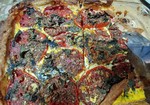Entries in wild mushrooms (7)
Chaga Mushroom
Chaga
The local medicinal mushroom! There are many shrooms with medicinal properties, but let’s just say this one is having a moment.. Finally, after a few thousand years of use! It has recently exploded in popularity in the west thanks to the wide array of purported health benefits from boosting the immune system, stopping tumours, stomach trouble and allergies to anti-aging.. Inonotus Obliquus, it is a parasitic mushroom that feeds on mature birch trees in northern climes. It is hard as a rock, so not a mushroom to sauté up for dinner, more like a tonic, generally consumed as an infusion or in powder form...
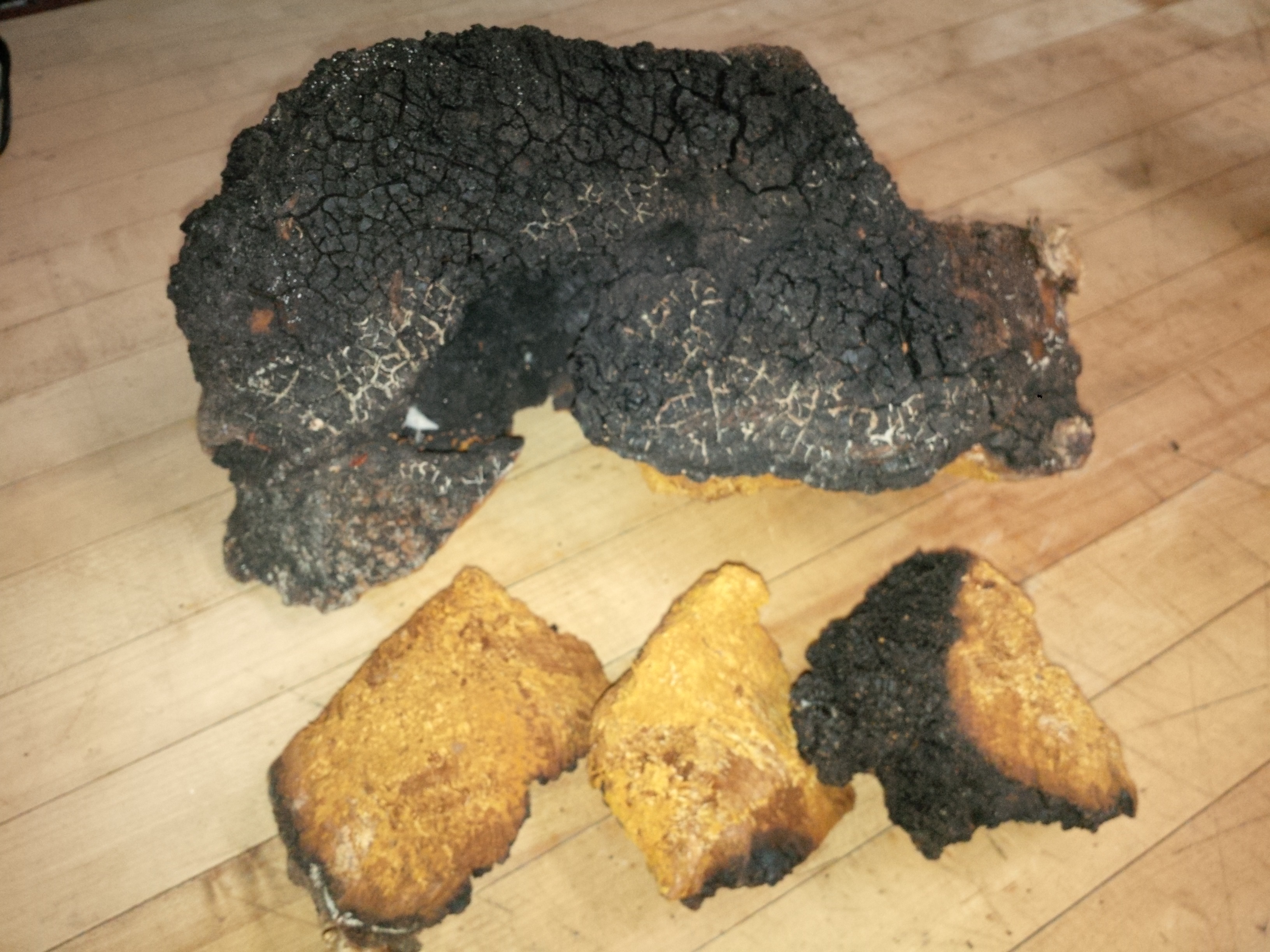
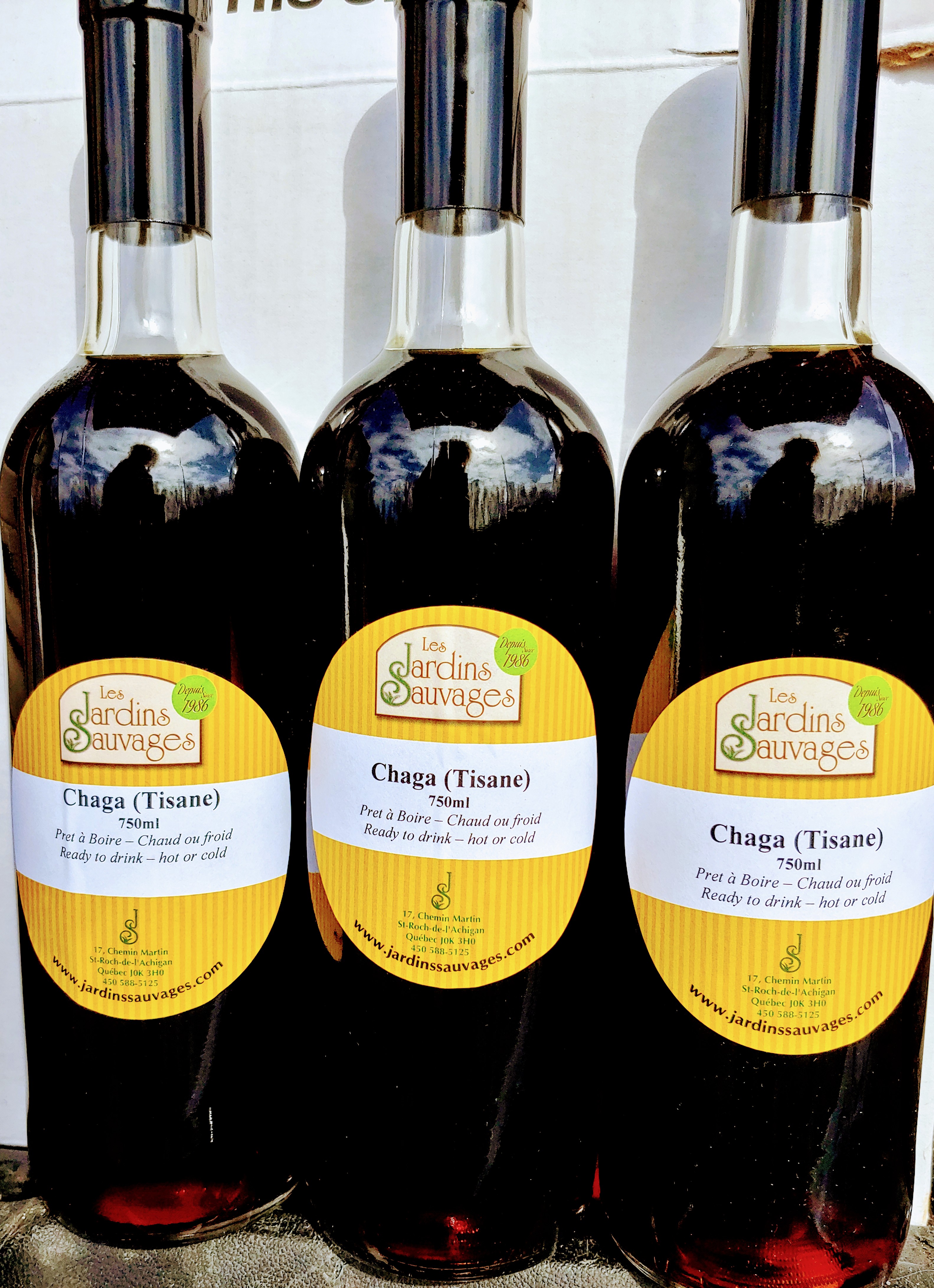
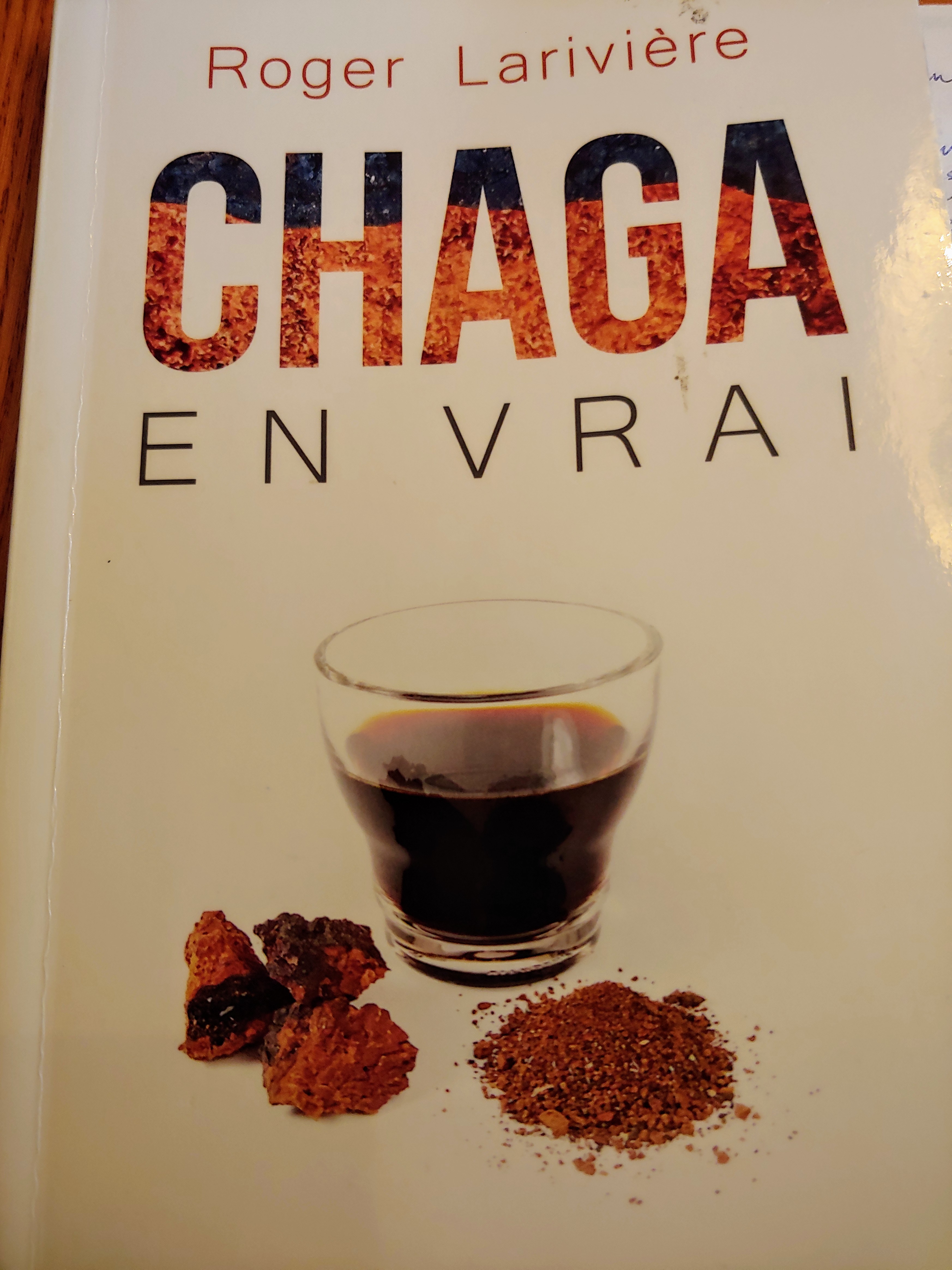
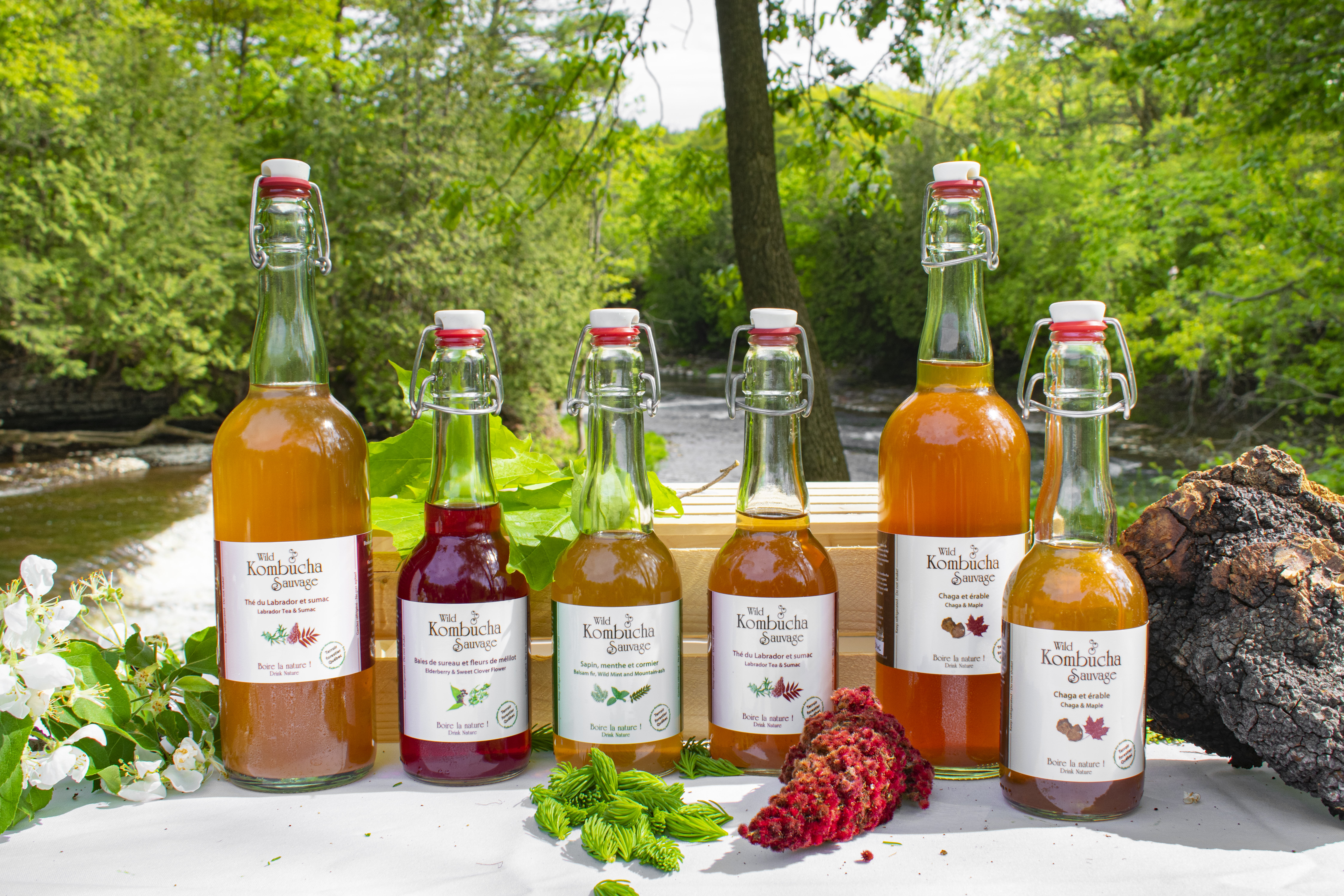
I was skeptical initially, when it came onto our radar like 10 yrs ago. Due to my ‘science background’, I am typically slow to jump on that kind of bandwagon. I do appreciate nature’s alternative ‘medicine douce’ to be used in parallel with conventional practice, but am cautious about miracle claims, equally annoyed with greedy pharmaceutical companies as with loopy charlatans who wreck it for the rest of us..
And at Jardins Sauvages, we were always about gastronomy first, and we still are.
Francois does love the stuff though, he drinks it every day. I find it kind of boring, so I don’t much. Funnily, many think I’m a passionate advocate of nutrition and wellness, when I’ve only ever been a gourmand(e), more like a hedonist. However with ethics and respect for the environment. So the local, seasonal, wild thing just fits, because besides being wholesome and making sense allround - for the soil, community too.. , it often is what tastes best.
We like to eat and cook delicious things period, mostly from the field and forest, small local farms, etc. The healthy or medicinal aspect was always bonus. When we would do tastings to introduce our wild greens /mushrooms/products to people, often they would ask ‘what are the properties?’ François would smartly respond, ‘Le bonheur, c’est délicieux’, (Pleasure, it’s delicious), first and foremost, and then add any other info as secondary. Because its true that yes, stinging nettle, dandelion, many wild greens and mushrooms, wild herbs and spices have documented properties, but we don't shout about it, focusing on instructing people how to prepare them properly for a satisfying meal.
When Chaga and Mushroom teas started to become marginally trendy, we decided to add it to our offer. Mainly because it grows in Quebec, can be harvested sustainably, and people want it.
So naturally, I was inspired to make a Mushroom tisane that was tastier – with other healthy but more flavourful mushrooms in the mix.. It has its fans, but I’ve realized that these are two different clienteles with little overlap. Those who want Chaga don’t care much about taste, they are seeking the medicine.. Those who are eating or cooking want the fresh mushrooms or other products, they aren’t necessarily interested in mushroom tea, haha. Meanwhile I was kind of wasting my time fussing because I found it so important that my mushroom tea be delicious.
Chaga has a light, woodsy aroma. I can appreciate it as is, if it lacks pizzazz. With a little maple syrup, the flavour is enhanced. I see increased complexity and apple notes in my Chaga Kombucha or in recipes with some fat/milk or alcohol/acidity.
As for the medicinal properties....
If you Google it, you will see that there is dizzying amount of info out there, from sketchy to scientific. There is work being done here at the University of Quebec in Trois Rivìeres. I bought this book by Roger Lariviière for François and upon reading it, I find it pretty convincing. Having long known about the anecdotal evidence from cultures like Siberia to Scandinavia, China, Korea and Japan, where it has been used for millennia as the secret to longevity and to treat tuberculosis, ulcers, and all kinds of ailments, it is only in the last couple of decades that research is quickly progressing globally. Now, science is catching up, which is pretty interesting.
In the fifties, when cancer started to take hold of medical journals and diagnoses started increasing worldwide, a Russian doctor noticed that there were no cases in areas where they had a custom of drinking chaga tea daily (a practice adopted when too poor to have imported tea!)
It is a mild stimulant, increasing concentration, which is why some people like to drink it like tea/coffee. But its most winner attribute/what most people are after are - is the overall immune system boosting effects, and anti-inflammatory, anti-viral properties. It has been shown to stop tumours in early stages, and to diminish the secondary effects of chemotherapy/ radiotherapy. It is high in anti-oxidants and enzymes that slow aging of the skin, hair, organ cells and aiding skin conditions like psoriasis.
It supposedly helps stabilize cholesterol and glucose levels, good for heart and blood pressure, slows allergic reactions by breaking the cytokine response, aids digestive tract issues with its anti-ulcer properties as well as the cellulose and chitins providing fibre. Oh and its spermicidal. These bio-molecules are all proven to be there, how bio-available they are upon ingestion depends on how it is prepared and on your microbiome.
Health Canada has it listed as a ‘aliment naturel’ (natural food/ supplement) and recommends not exceeding 3.6g/day (dried), safe except caution for those with penicillin allergies, on anticoagulant medication, with organ transplants and heart tremors.
The medicinal value/potential health benefits depend on how it is extracted and consumed. The active ingredients are either fat soluble or water soluble, so to get lipids like erosterol, inotodiol and polysaccharides like betulin, BTA (anti-cancer/anti-viral), and A, E, D, K vitamins, you need an alcohol extraction like a tincture.
But there is still lots of good stuff in the aqueous tea like the betaglycans, most of the anti-oxidants, melanin and polyphenols, SOD enzyme (also anti-viral/anti-inflammatory, allergies, skin etc), and protein (animo acids), as well as the B vitamins (B2, B3, B5 ) and minerals (Si, Cu, Fe, Al, Mg Na, zn, K). What an impressive cocktail!
But no, it is not a quick fix for anything. Like many medicinal plants and ‘adaptogens’, it is only with regular consumption over time that reveals healing and protection. Like with a varied healthy diet! Which only tends to be sustainable if routine, comforting and/or delicious...
I now find myself taking a glass here and there, and introducing it in my cooking more.
I always used it in tisanes, coffee, and some infusions (sauces, desserts), but often half heartedly; it felt more like a gimmick, whereas now I pick it up to layer it in with intention, and a shot of extra love.
We sell it at the market (and our online store) in dried chunks or powder, and upon demand, we have added 750ml bottles of prepared Chaga beverage that keeps in the refrigerator for a month or so.
When making your own, you want to keep in mind: In order to benefit from the multiple properties, you want a slow and long extraction, but should be careful to not heat it higher than 80C. I heat it in water to cover and turn off, leave overnight (in the fridge ideally), and do that 3x.
You can add drink it hot or cold straight up or mix it into coffee, hot chocolate, tisanes, broth, soups and sauces, smoothies or just about any recipe savoury or sweet at the end.
From Wild Booch back to Wild Shrooms
My new baby – ‘Wild Booch’ - Kombucha Sauvage
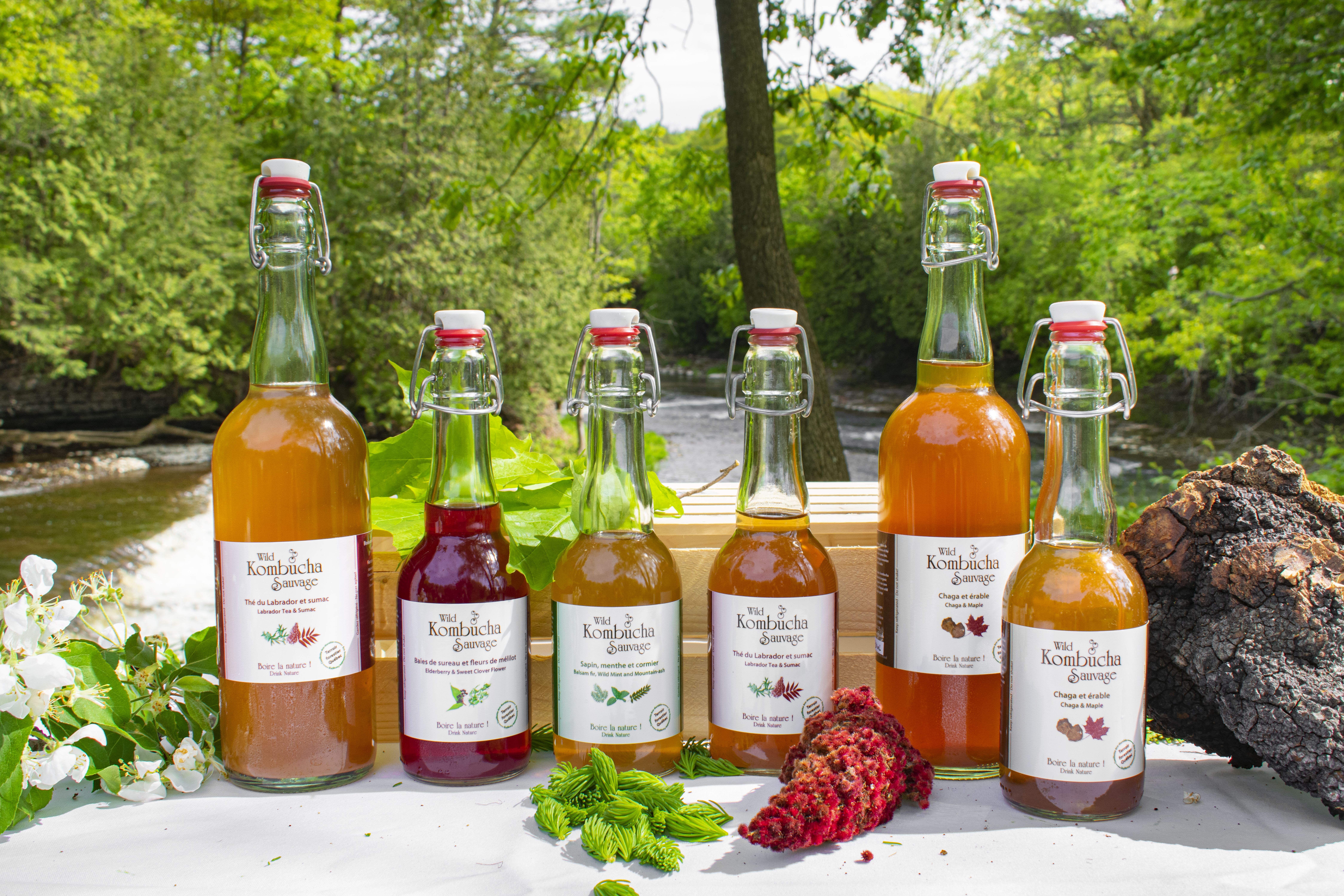
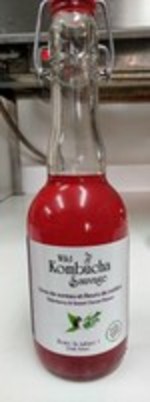 My sexy labels are thanks to Yves (Menu&Cie)
My sexy labels are thanks to Yves (Menu&Cie)
More than a year into this adventure now!
A curiosity turned hobby turned little side business..
It all started with ‘the sodas’ (Soda Sauvage) which I had been working on bringing to market for a couple of years since we began carbonating our maple sap in spring 2016 for fun. François liked it plain, but I wanted flavour! I got to playing around and finally called on Ryk, a soda enthusiast, who coached and lent me equipment for my first bottling. With some further research, trials and a few explosions later, I invested in the basics and got it down. Once my sumac maple sparkling water was set and adopted, it spawned a line of ‘sodas’ featuring clean and subtle flavours from the forest.
Then I caught the fermentation bug after taking a class for professionals with Sebastien Bureau (Mannanova), and began fermenting everything in sight. Scary looking (and smelling?!) experiments were bubbling all over the place between the restaurant and our house kitchen counter and cupboards, François found it frightful - until he was sold. Kombucha became a daily libation for both of us, as well as an amusing project for me – an open template for exploration.. As I have been cooking with all these local wild plants and mushrooms for so many years, it was only natural that François’ foraged treasures would end up in our glass as well! The Kombucha came to overshadow the sodas only because it happened to be trendy and more punchy, more market friendly in the moment.
(In case you’re not familiar with Kombucha, it is a naturally sparkling beverage made from fermented sweet tea that is refreshingly sour, and supposedly super good for you and your gut.) Look it up!
I just think it’s delicious, when well made.. Besides the composition of your mother (SCOBY), and kind of tea, ingredients, herbs and spices you use that go into it, not to mention the brewing temperature and method, there are many different styles. At Montreal’s Boochfest recently at Jarry Park, I tasted everything from sweet, commercial, ultra filtered carbonated ‘phony’ Kombucha to super pure, bland tonic, as well as super dry, overly aromatic concoctions and everything in between. Every aroma under the sun and a wide range of effervescence, on offer from big international companies to hyper-local artisans, all with a unique booch. And from observing customers, it became obvious that everyone seems to appreciate something different too.
Personally I favour a fermented product (so acidic) with minimum but some residual sugar to balance, with a real tasting flavour that is not overpowering. I find that almost every beverage on the market tastes artificial even if they claim to use ‘natural’ flavour; my pet peeve! Although there might be slightly more authenticity in the Kombucha world than with soft drinks or ‘waters’, marketing remains omnipresent and just as misleading as it goes mainstream, the bigger brands already in supermarkets..
I love my bubbles, but I stop them short a bit to have stability in the fridge since I don’t extreme filter out all the good stuff. At home, I often allow for a longer 2nd fermentation and even leave the fruit/herbs in, but not a good idea for business.
My four flavours offer up each a different personality: The Chaga-Maple is Soft and Easy, intriguing for the medicinal mushroom factor; Labrador Tea-Sumac is sharp, astringent and refreshing, my favourite but apparently the least so with customers beyond Booch old timers.
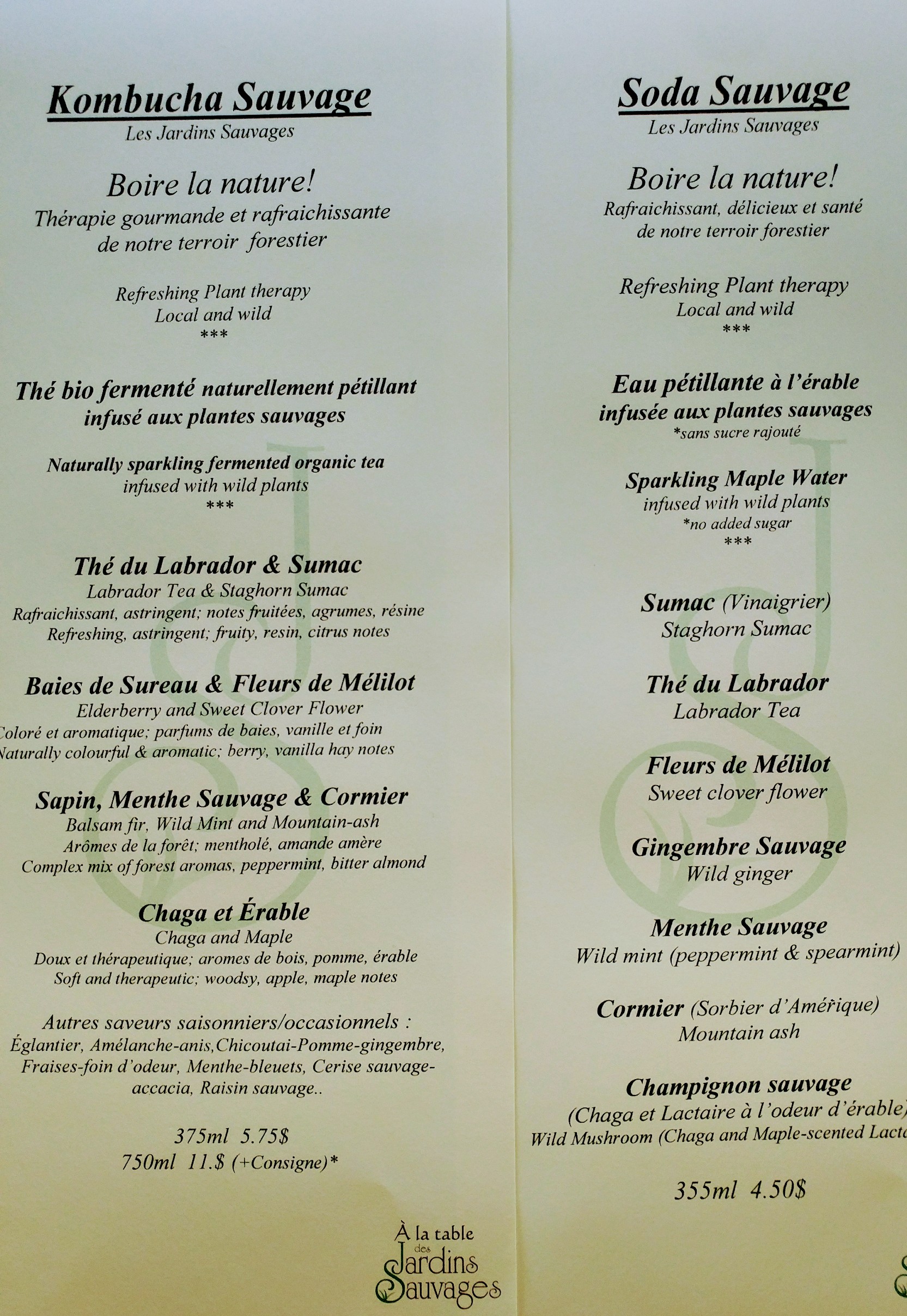
The crowd favourite seemed to alternate by the week at the market, but now has settled on the Balsam Fir, Wild Mint and Mountain Ash. It is the most complex, like a walk through the forest. ‘The chicks’ seem to like the Elderberry-Sweet Clover Flower with its pretty colour and wild vanilla-like grassy notes. We also have many seasonal flavours that we serve by the glass (Kombucha du Jour) at the market like Strawberry-Sweetgrass, Black Raspberry-Anise, Wild Mint-Wild Blueberry, Cloudberry-Apple-Ginger, etc.. http://jardinssauvages.com/index2.php?nom=Kombucha_Soda
Good stuff.
It is not hard to make at home for your personal consumption, if you’ve got some SCOBY *(Mother) and are on top of it. (*A symbiosis of good bacteria and yeasts that turn the sugar /alcohol into acetic acid, among other organic acids)
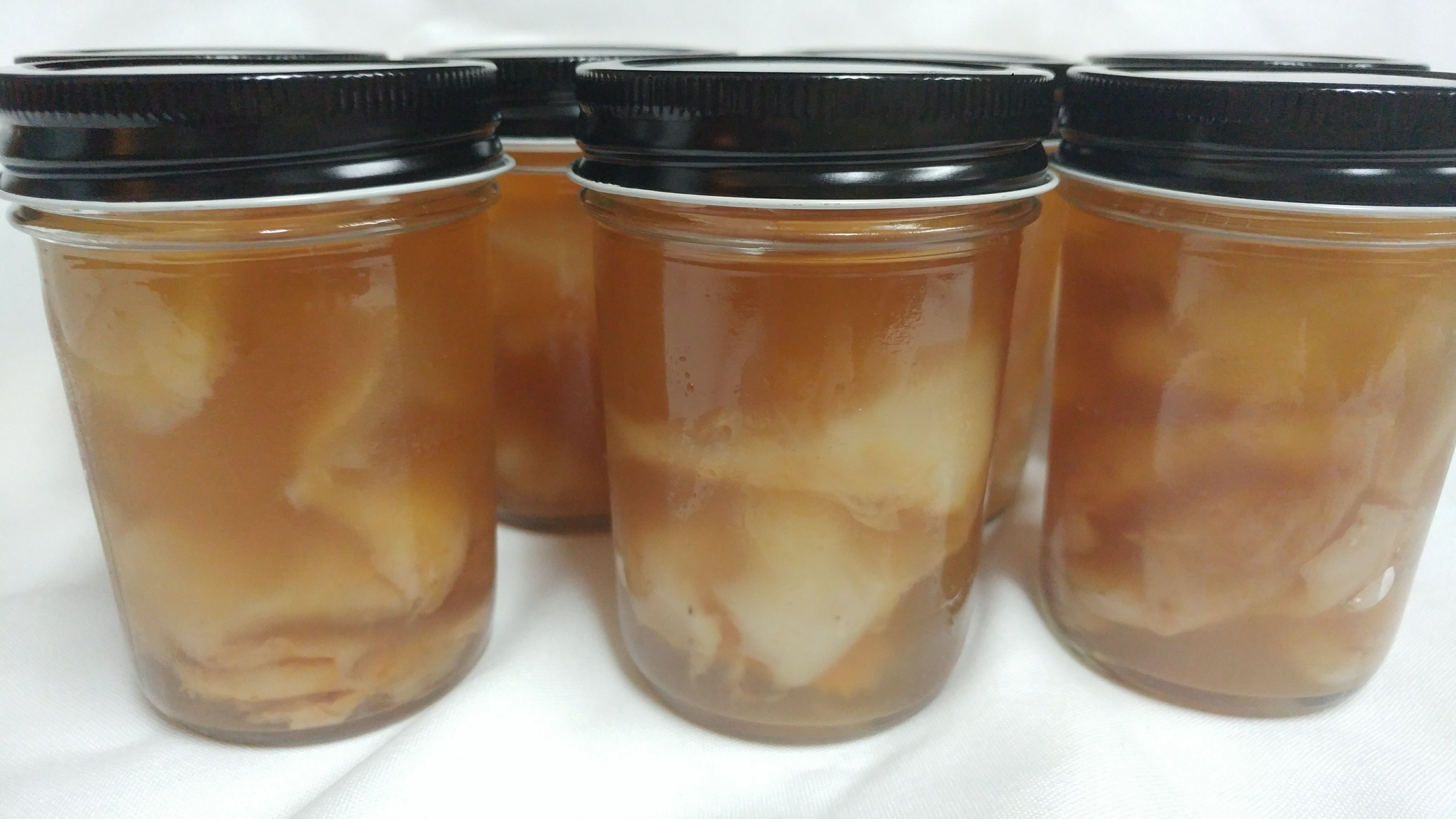
Of course, as I soon discovered, brewing booch at home is one thing, doing it on a larger scale and commercially is whole different game. Achieving a regular, consistent and stable product while remaining artisanal, favouring a top-quality and healthy alive product is a challenge. I learnt a lot in the past year growing slowly, organically, tinkering with all the parameters, doing everything on my own from the recipes to the heavy lifting, methodology, logistical troubleshooting, adjusting variables, tweaking... Alongside my reliable refractometer, I have two Ph-o-meters, but my tongue is the best. All to say, I’m humbly quite pleased with my progress and my line.
As I’m rolling in hundreds of liters and not thousands or hundreds of thousands, my operation is still way small relative to the commercial booch, and we are not distributed - only sold at our store (Jean Talon Market, Mtl), our country table in St-Roch de l’Achigan and on order, for a select few restaurants with a local menu/beverage program, like the Monkland Tavern in NDG ..
At a crossroads, I’m unsure what the next step should be, as I’m maxed out with my current set-up. I could take on a couple of clients, that's it. My plan. We’ll see what the future holds for my Kombucha Sauvage.. I am taking a commercial class on big-scale brewing to enlighten me before further investment.
Who’s kidding who, I am a chef first and quite like it that way. I kind of want to keep up this beat, with my brewing as a sideline, but I can’t help but be excited about the possibilities. But it’s not like I can go BIG anyhow; it must remain artisanal as it is made with REAL, WILD, SUSTAINABLY hand harvested plants and berries, ie. Can not be mass produced. Which is what makes it so special – delicious and therapeutic! Not to mention expensive.. That's why I think it's meant to be just for this scale and a handful of clients with the right clientele - who are ready to pay for something special, like a glass of wine.. A suivre!
One thing for sure, for now, I need to focus on the wild mushrooms and the rest of our business as it is fall, our busiest season. Already!
It’s been a beautiful, yet very dry summer, and so a slow start to the mushroom season; we’re like a month behind, yikes!
Normally by now, I’m several hundreds of pounds into my putting up, not twenty (out of an average of 2 tons/year on average!). Besides some chanterelles and Lobster, a smattering of this and that: a few boletes and milkcaps, not much going on. No puffballs, porcini or hen of the woods to speak of, the stars of late summer/fall.
However, with the recent rainfall, nice days and cool nights, it just might explode. Fingers crossed! A few inspiring photos from last year on our facebook page and this year's menu
https://www.facebook.com/JardinsSauvages17/
The reservations are coming in for our annual mushroom fest, so it will be a mad dash as usual, weehoo.. http://soupnancy.squarespace.com/wild-mushroom-event-october/
Always a tad stressful, yes, but I do love this dance with nature. And everything about the seasons.. How delicious is life now? Not just talking wild things here - the peaches, the corn etc! Yum. It's hard to not want to celebrate these gorgeous days, the glorious harvest season, and all that we are so lucky to have..
Foremost, here’s to Mother Nature, our dance partner throughout the seasons, and the marvelous bounty she offers up for our food and drink, not to mention in sights and sounds; the moon, the cricket/birdsong and the whole shebang.
Cheers!
Happy Mushroom season to us! Let the season of the dirty fingernails begin..
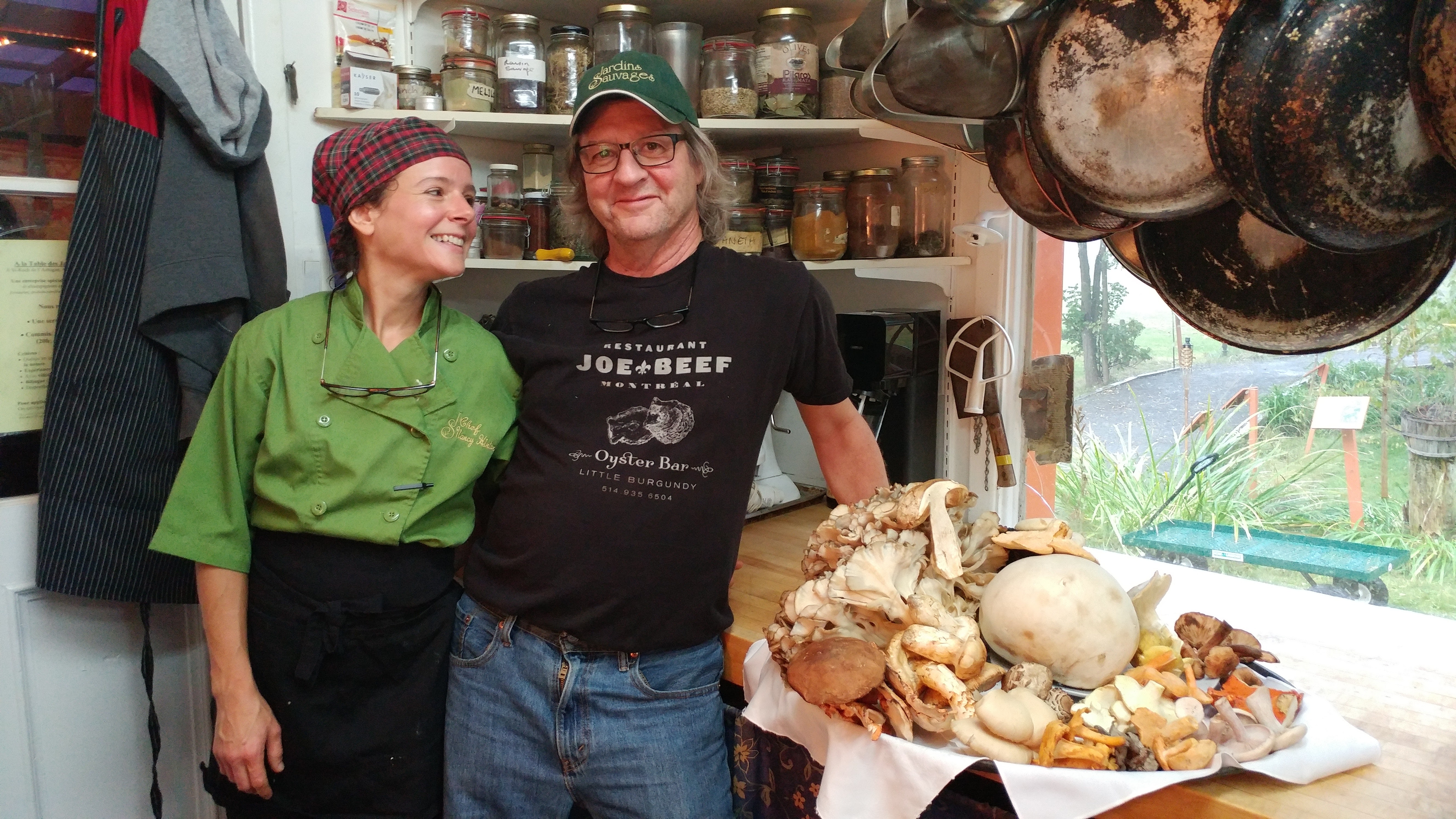
Fall Mushrooms and Puffballs
Finally, the local wild mushrooms are out in full force!
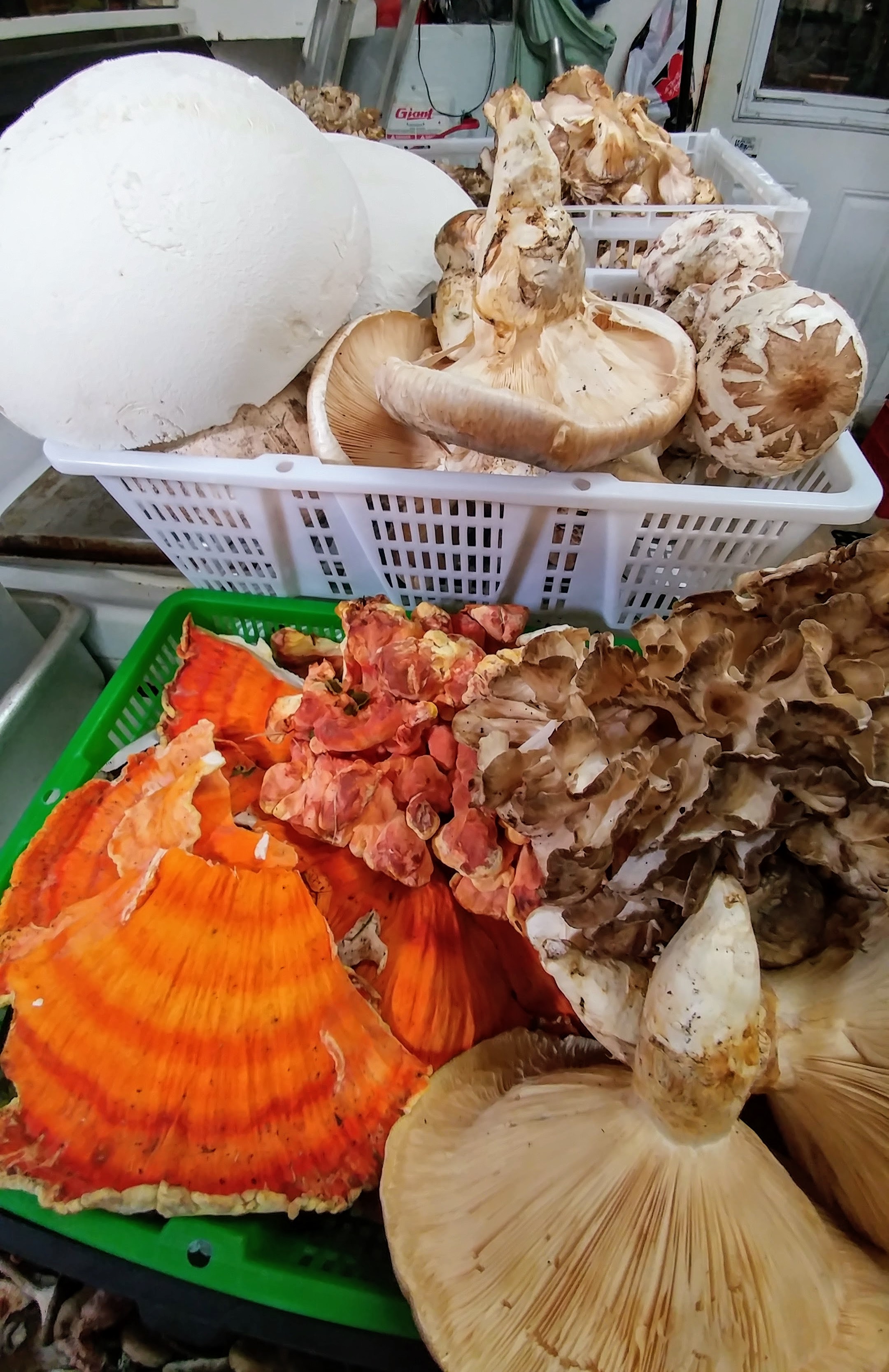 An autumn day harvest
An autumn day harvest 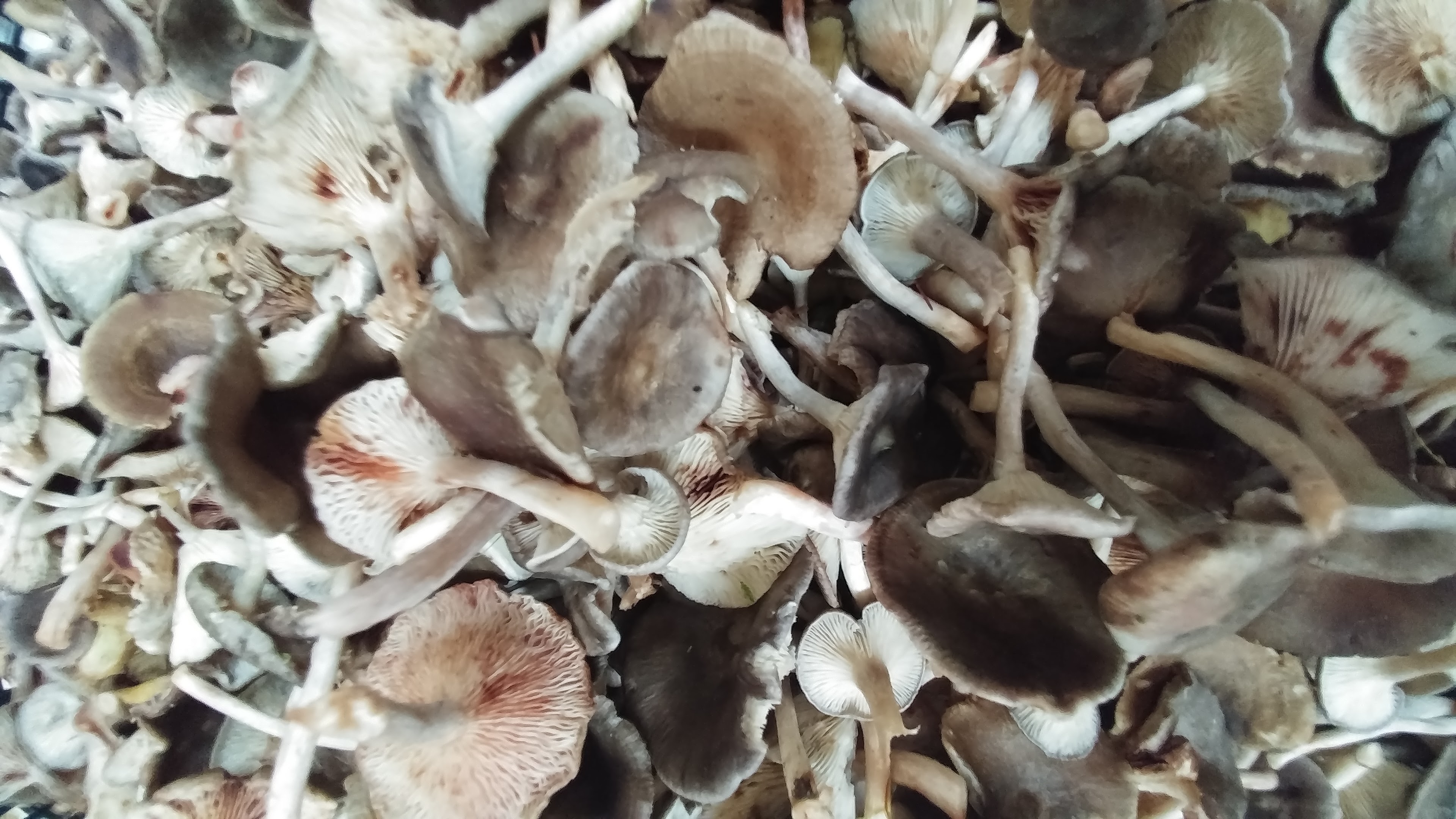 graylings - a rare treat in the chanterelle family
graylings - a rare treat in the chanterelle family
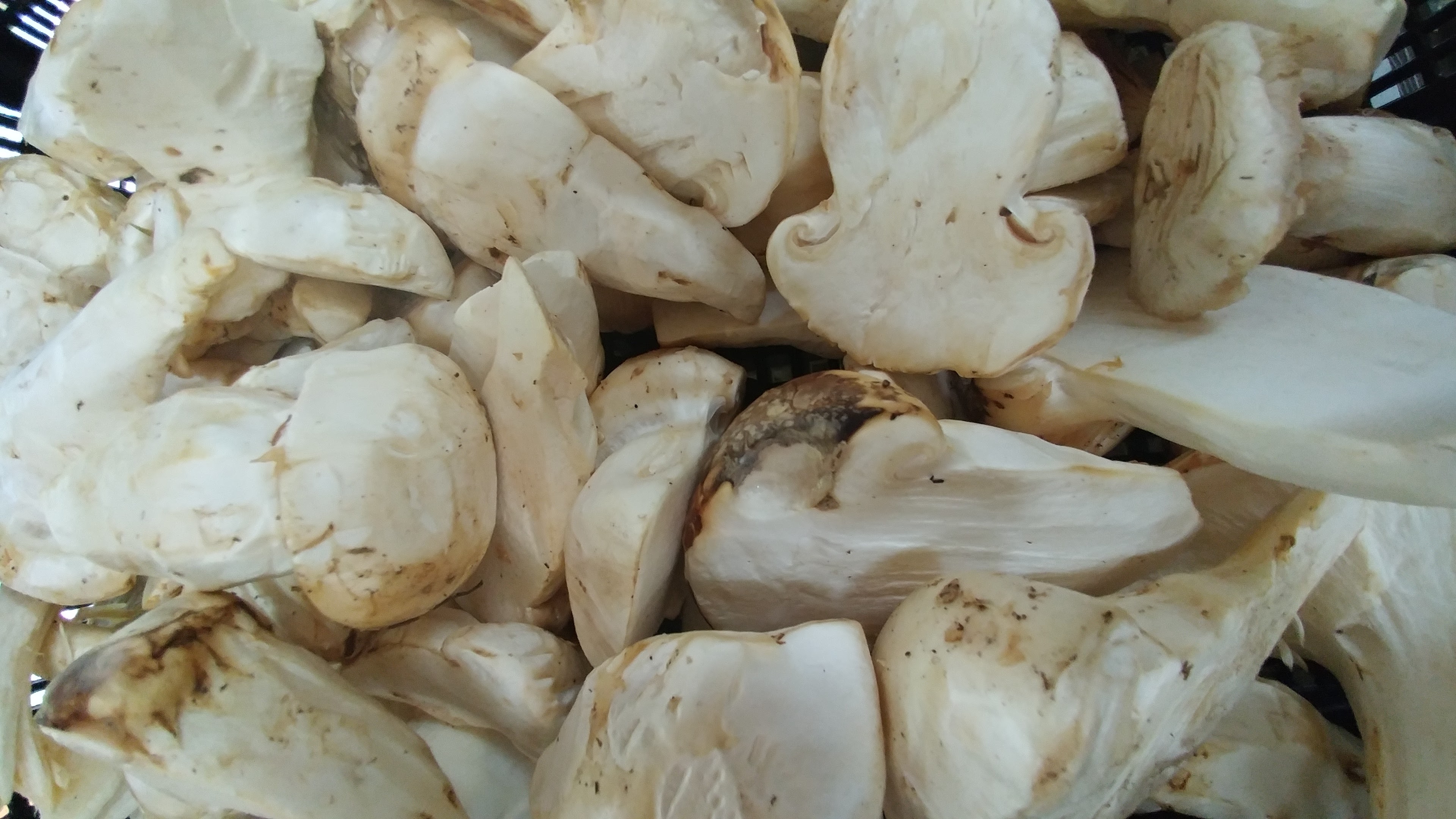 Armillaire pesant; Swollen Stalked Cat
Armillaire pesant; Swollen Stalked Cat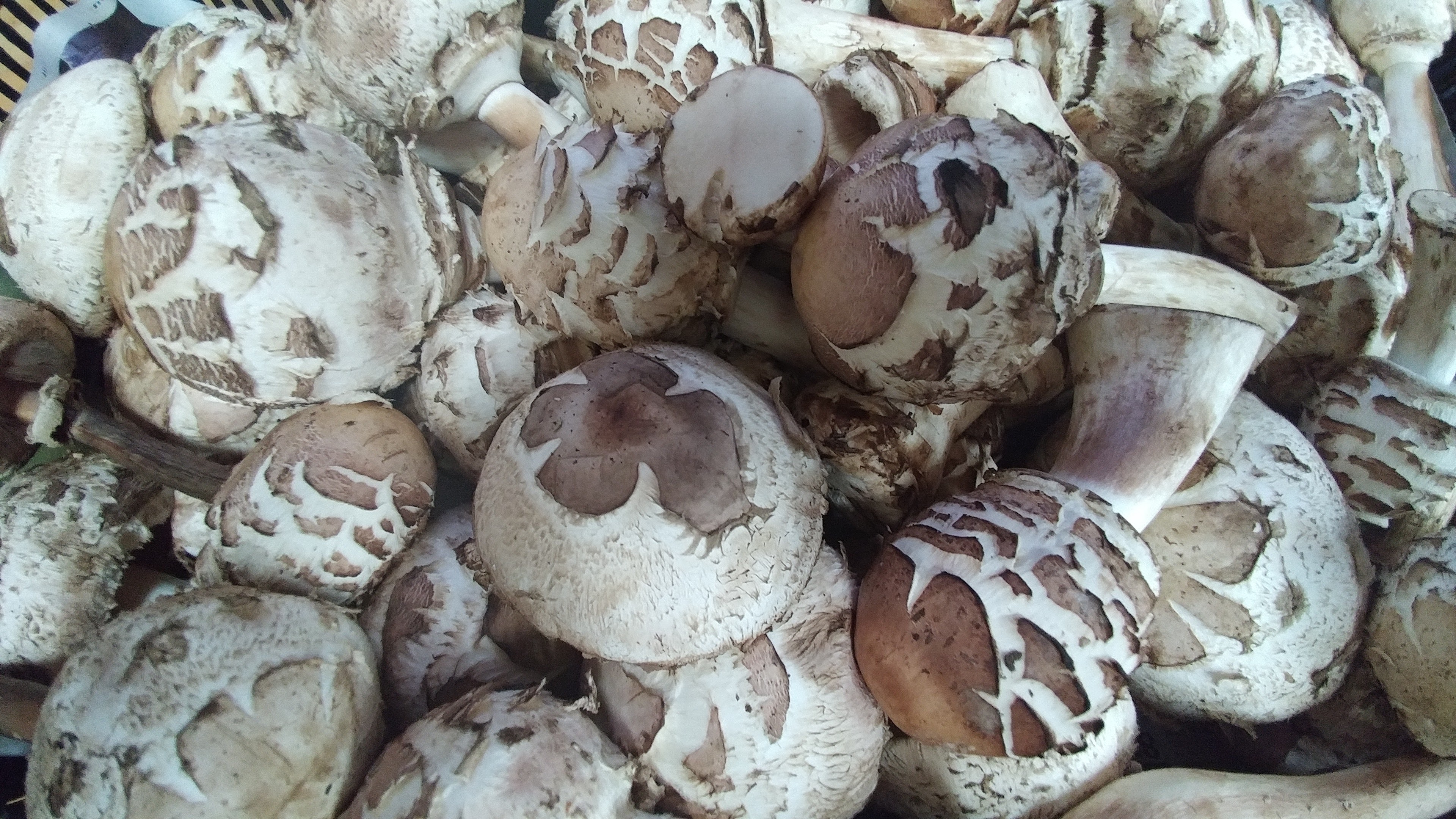 Parasol
Parasol
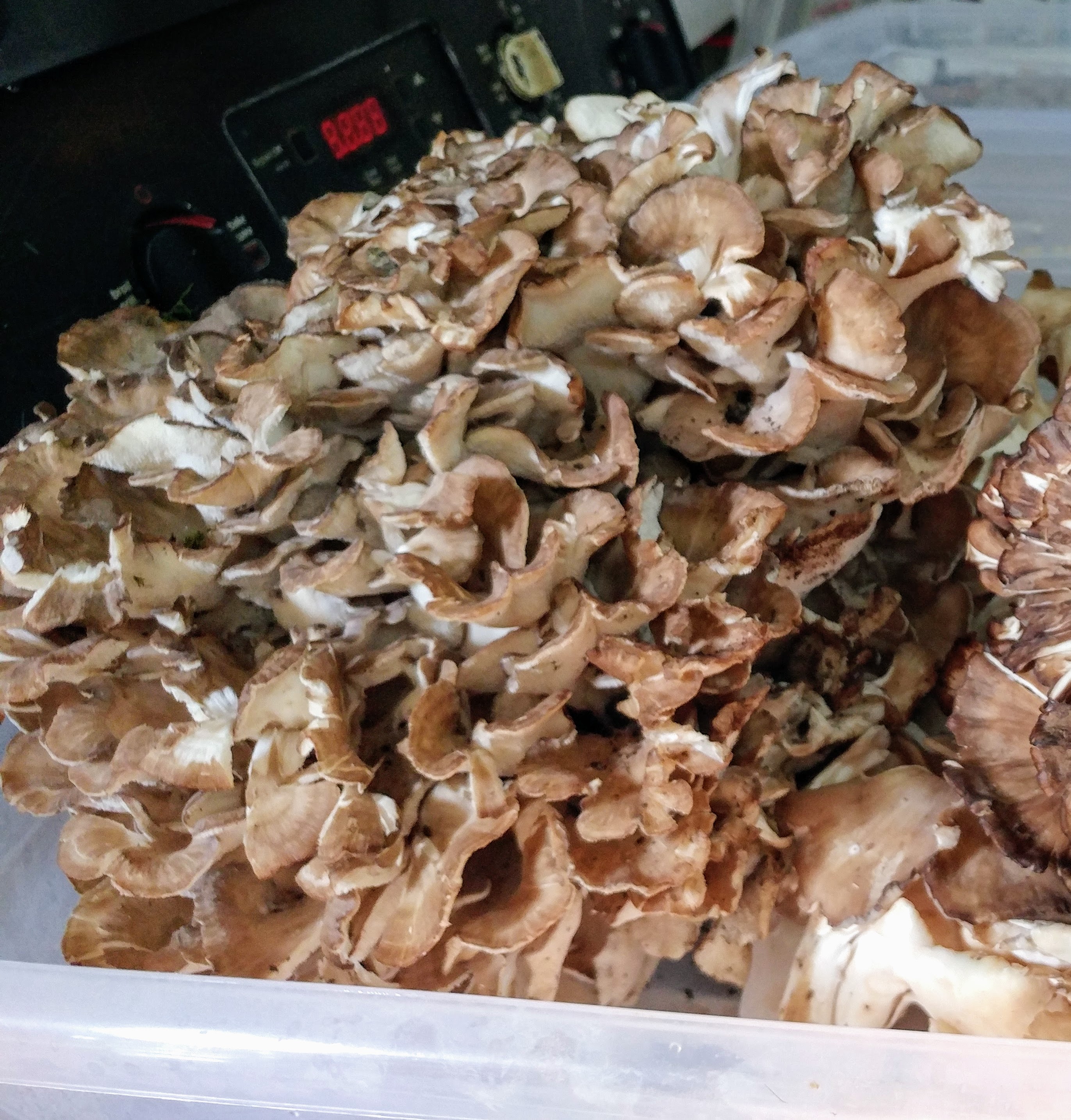 Hen of the Woods
Hen of the Woods
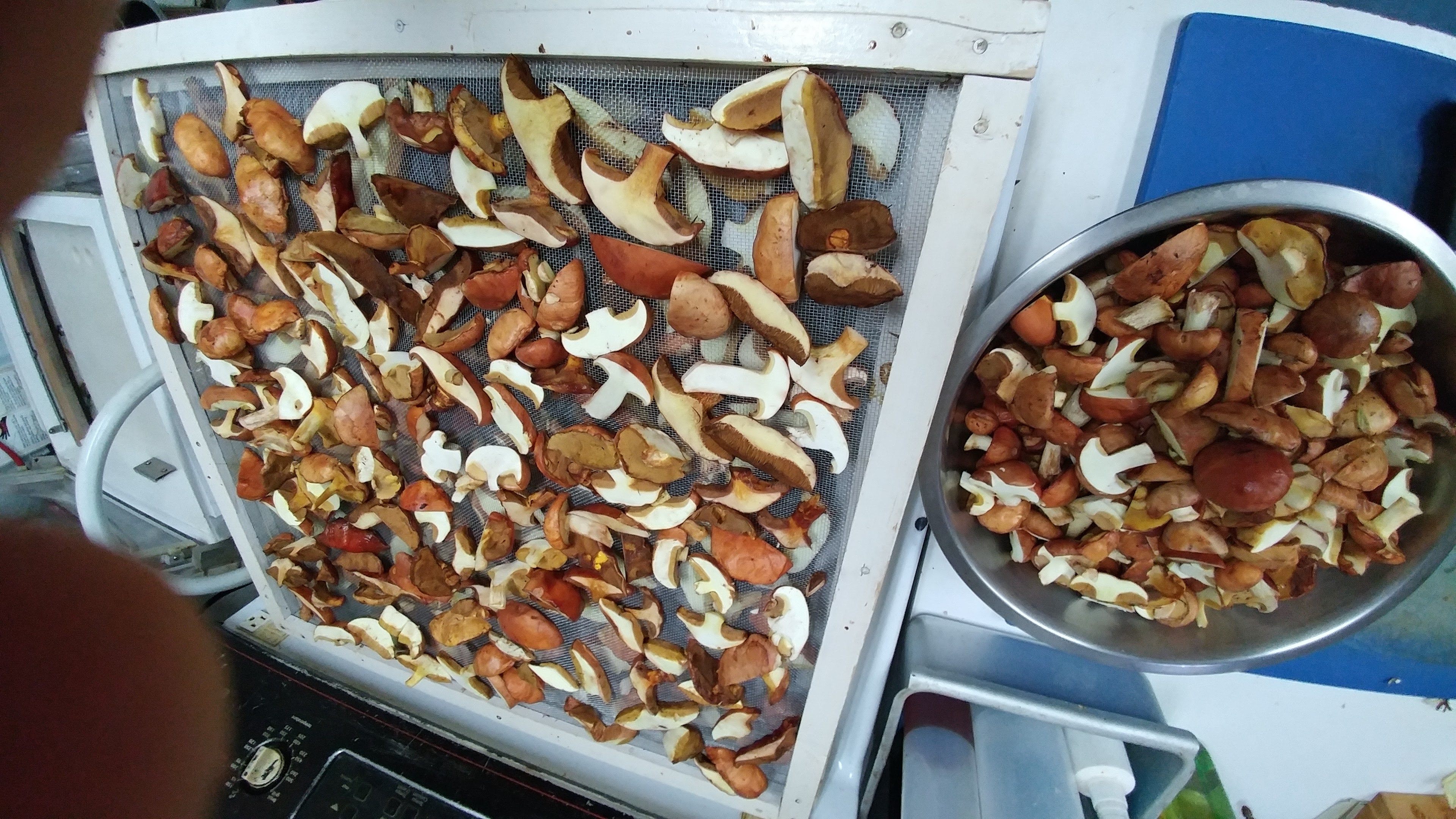 Slippery Jack - a yellow bolete that is especially good dehydrated.
Slippery Jack - a yellow bolete that is especially good dehydrated.
 Poule des bois/Hen of the Woods haul
Poule des bois/Hen of the Woods haul
Besides the Hen of the Woods (our favourite), the most spectacular is always the giant puffball, in season now.
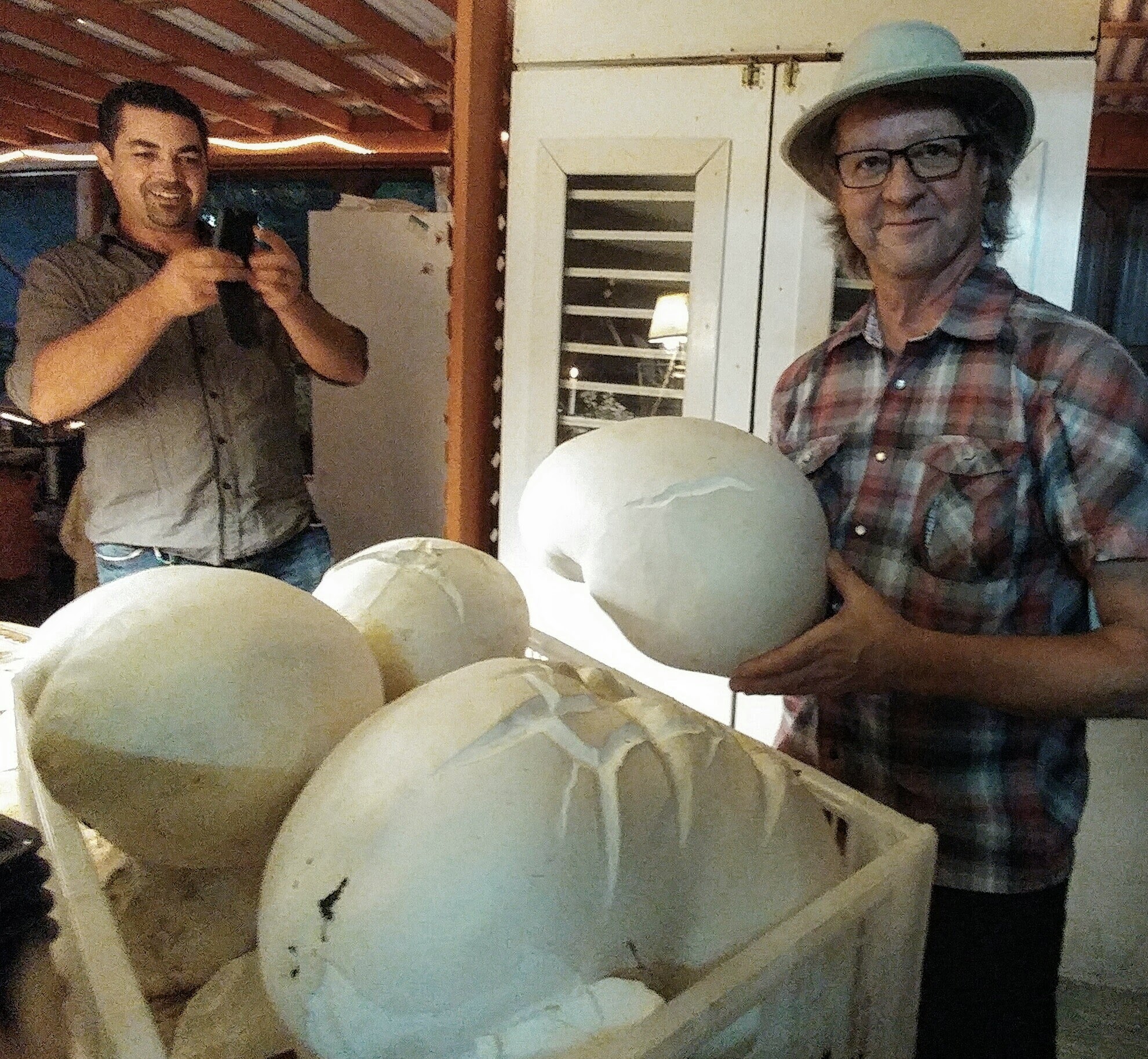
I have had multiple inquiries on how to cook it.
So, here’s the deal. It is easy enough to identify; if it is still firm and pristine white throughout when you slice it, it is good to eat. They go yellow and soft (not to mention) pungent smelling as they age past their prime.
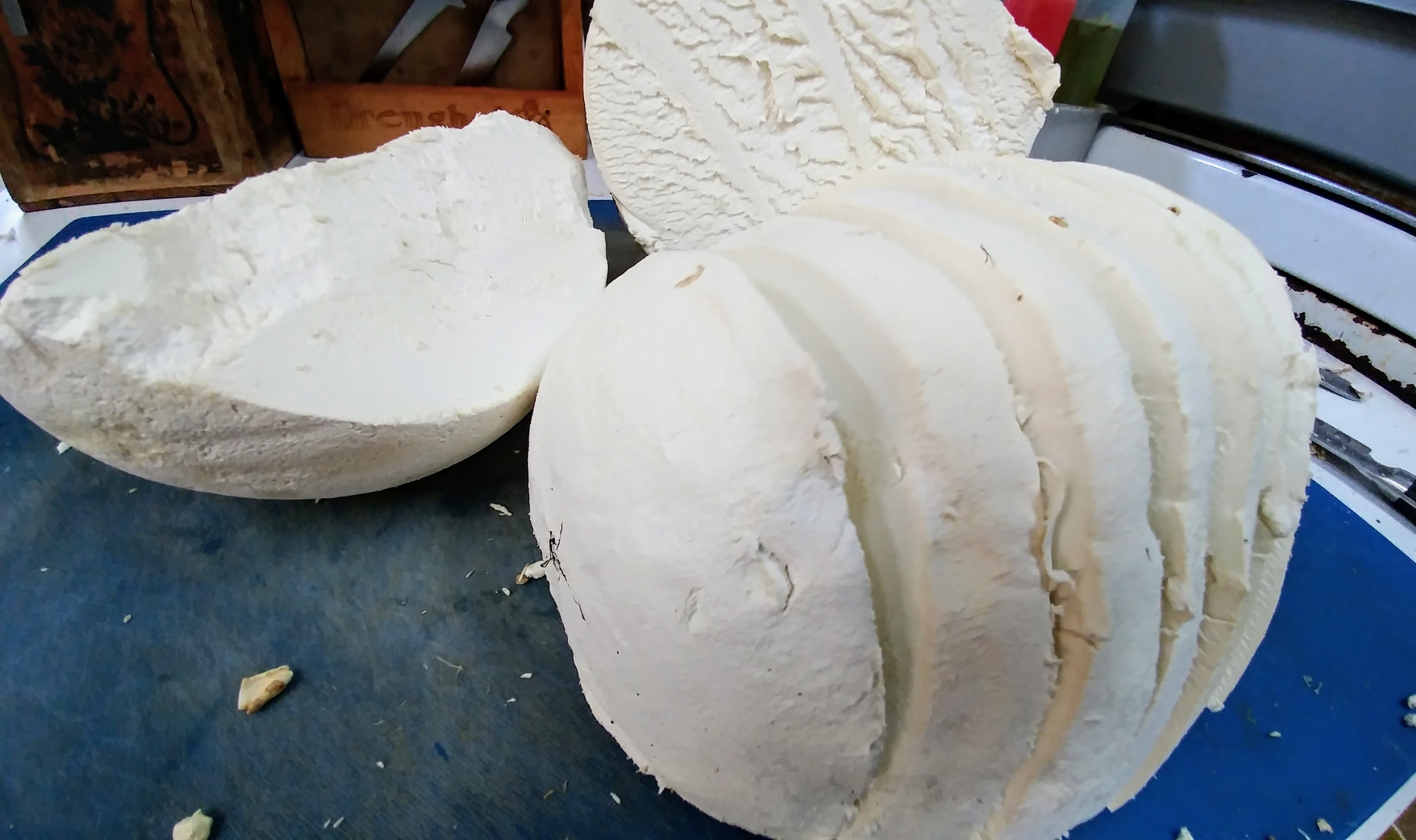
The best way to cook a giant puffball:
Peel and slice. Pan-fry or bake on parchment with a good amount of fat (I start with oil and finish with butter), flipping half way through. You want to gently brown it, on medium heat as opposed to high.
With its sponge-like texture, I find that it cooks up quite like eggplant. Best eaten straight out of the pan, it gets soft and loses volume as it sits, although it will taste good no matter.
It has a strong (ish) mushroom flavour, so I like to layer it with other flavours like tomato, cheese or root vegetables in a lasagne or gratin for example. It makes good soup too. You could dice it up and make spaghetti sauce, the options are endless.
It's not all about the puffball, especially with Matsutake season starting. I'm busy putting up the fall boletes for our dried mixes and butter etc, as well as yellowfoot chanterelles and hedgehogs, hundreds of pounds a week. We are still waiting on the autumn oysters and another half dozen varieties to complete my upcoming annual mushroom fest menu.. http://soupnancy.squarespace.com/wild-mushroom-event-october/
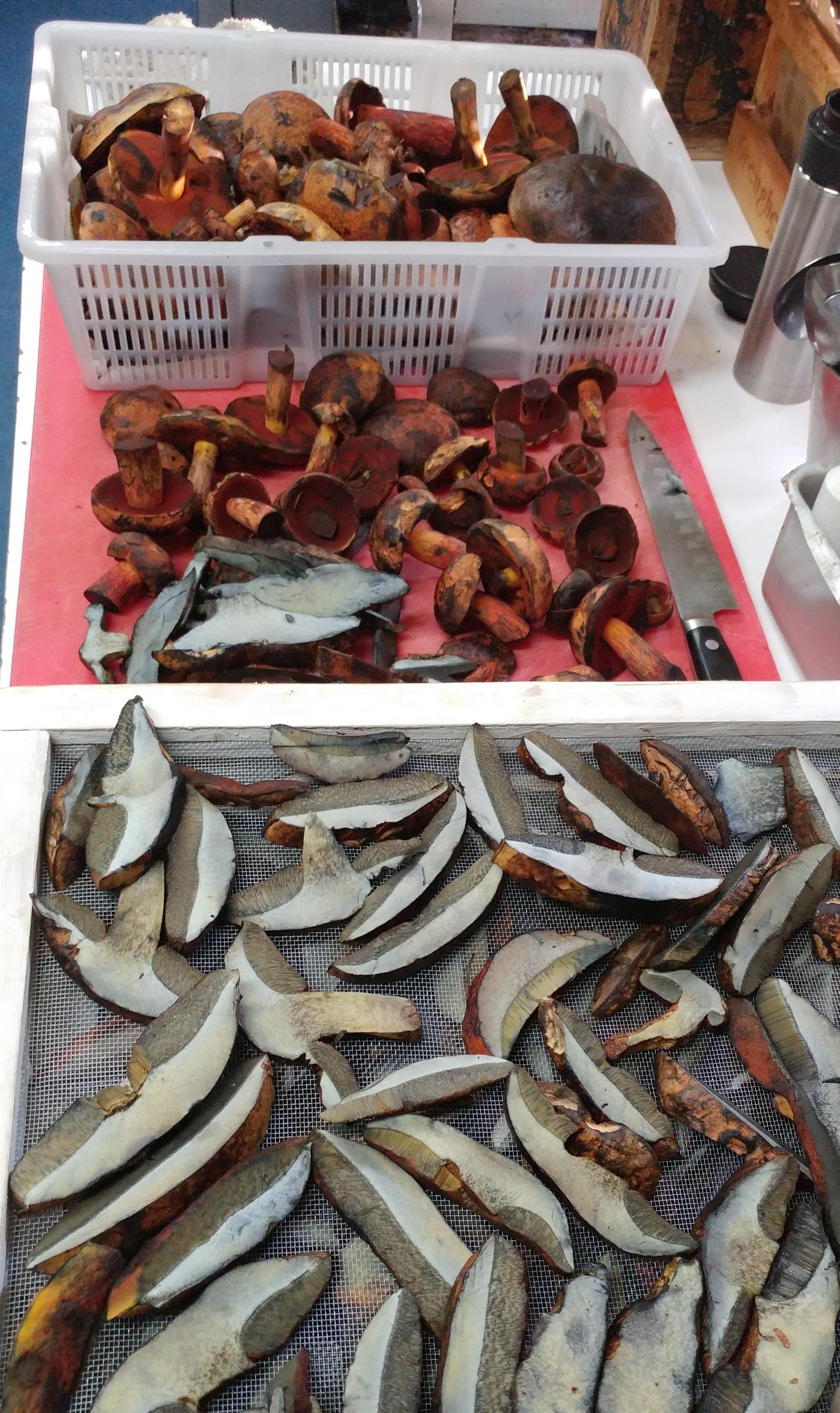
Red Mouthed Bolete, a dessert fave
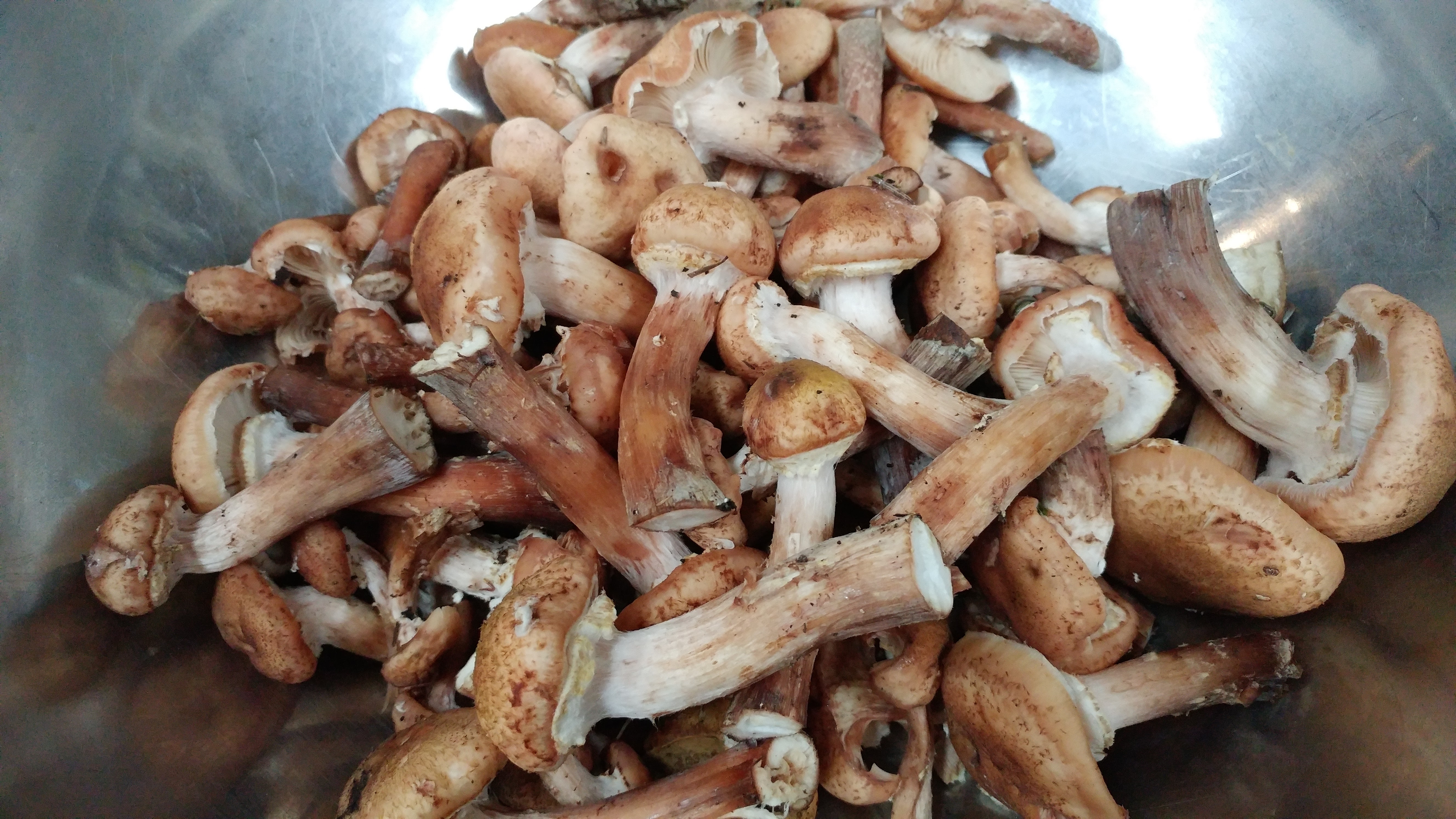 Armillaires Couleur de Miel; Wild Honey Mushroom
Armillaires Couleur de Miel; Wild Honey Mushroom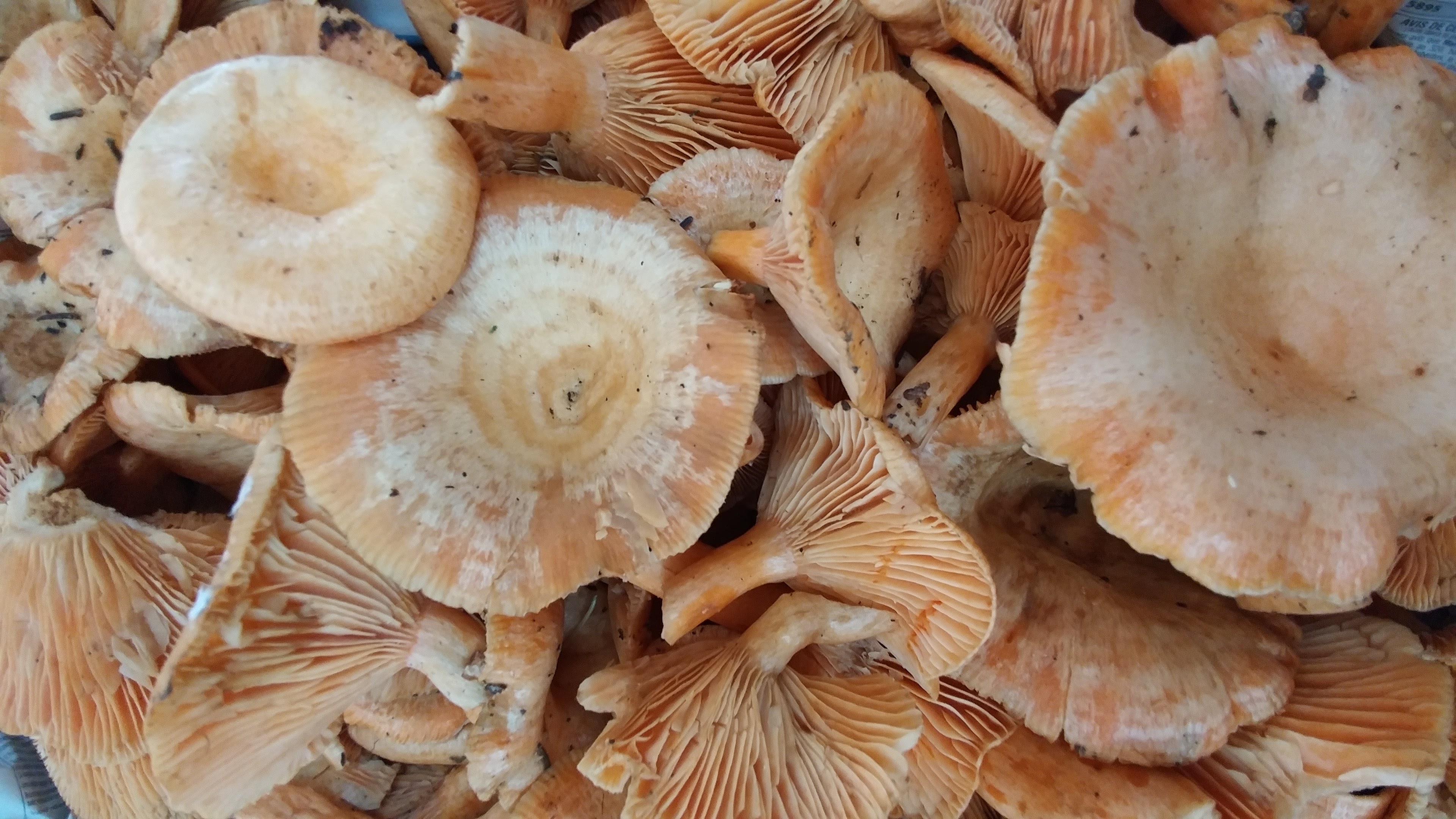 Lactaires Delicieux
Lactaires Delicieux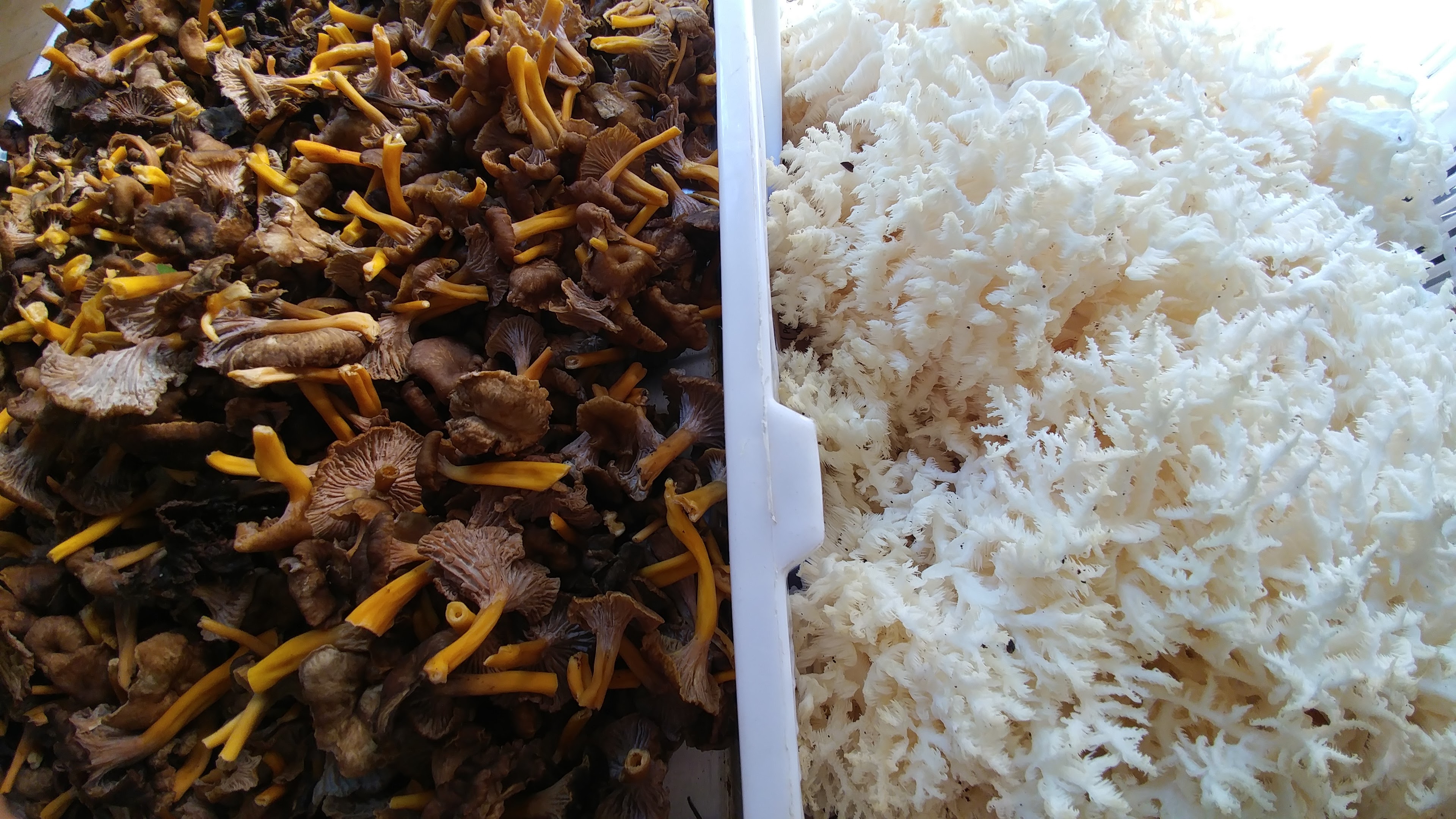 Comb tooth and Yellowfoot Chanterelles
Comb tooth and Yellowfoot Chanterelles
François' tomatoes, and a few summer recipes
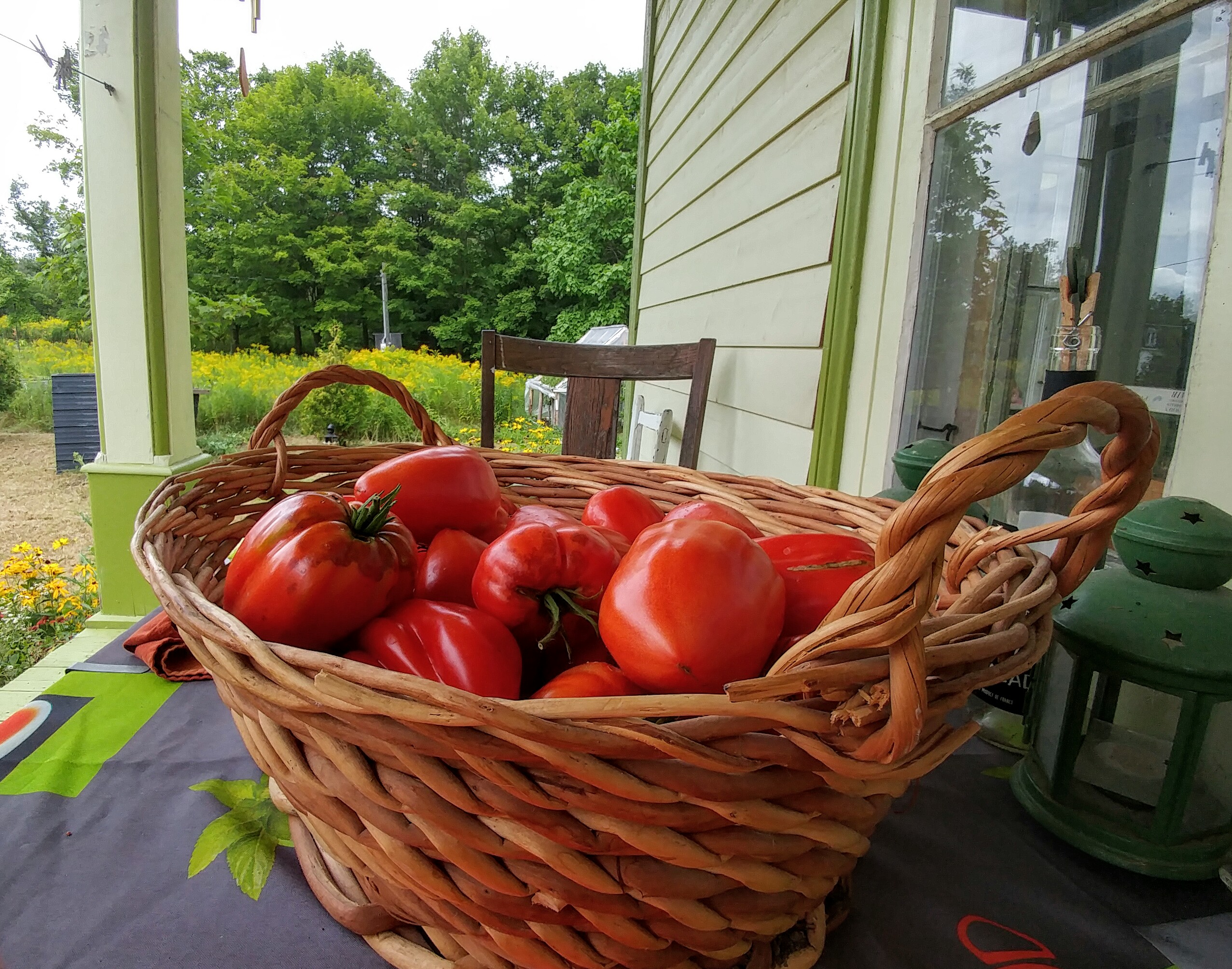 We may as well talk about tomatoes since there isn’t much going on in terms of local mushrooms. What a crappy season so far. I mean we’ve had a few good harvests but we are not meeting the demand at the market, and with a trickle for the restaurant menu, I haven’t started putting up. When you consider that I typically process 2 tons of mushrooms for our year (to supply the restaurant and make our products), I will have to get started soon enough.. Pretty frightening. Fingers crossed.
We may as well talk about tomatoes since there isn’t much going on in terms of local mushrooms. What a crappy season so far. I mean we’ve had a few good harvests but we are not meeting the demand at the market, and with a trickle for the restaurant menu, I haven’t started putting up. When you consider that I typically process 2 tons of mushrooms for our year (to supply the restaurant and make our products), I will have to get started soon enough.. Pretty frightening. Fingers crossed. 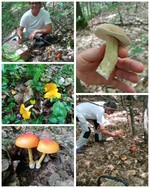
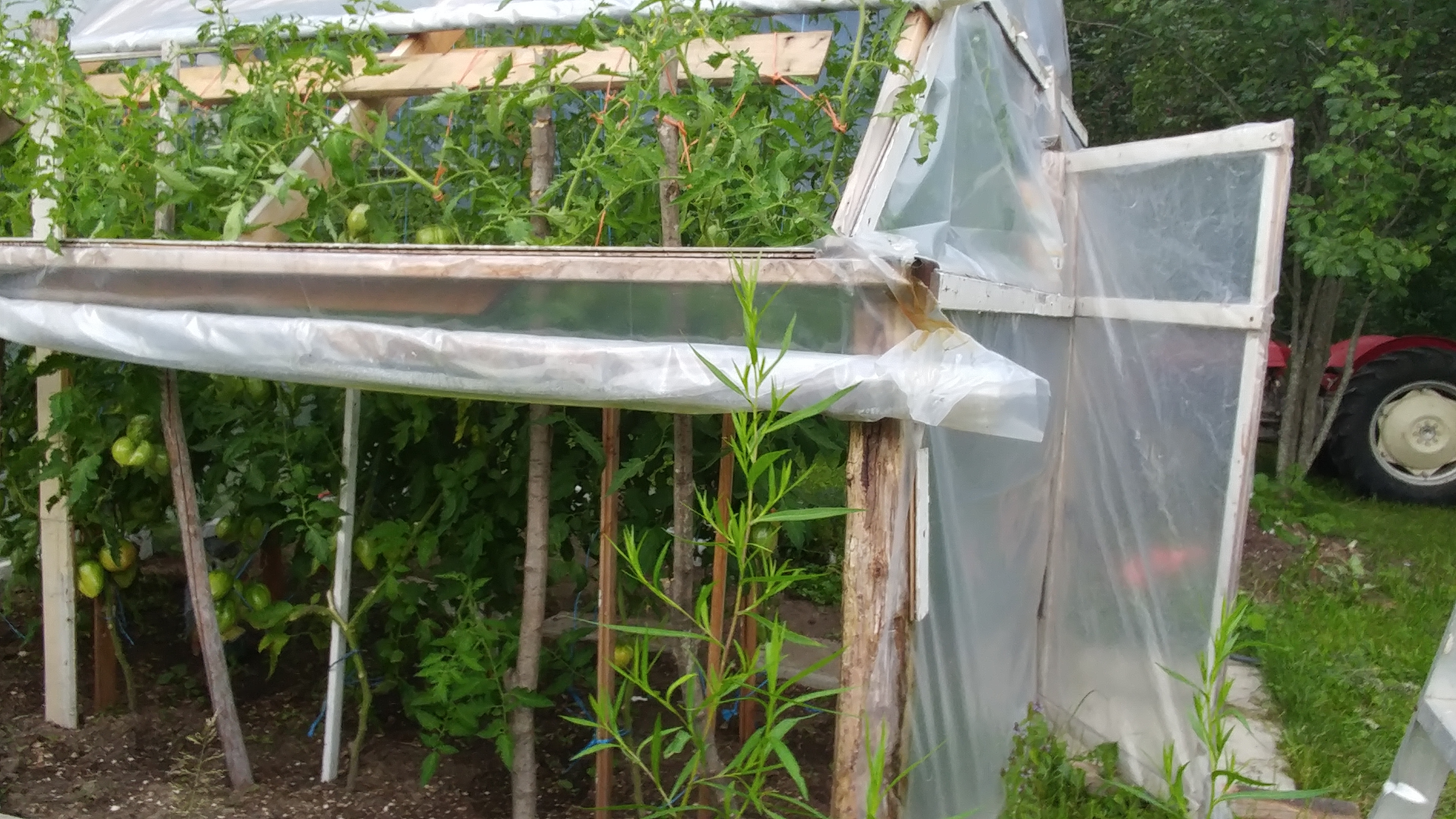
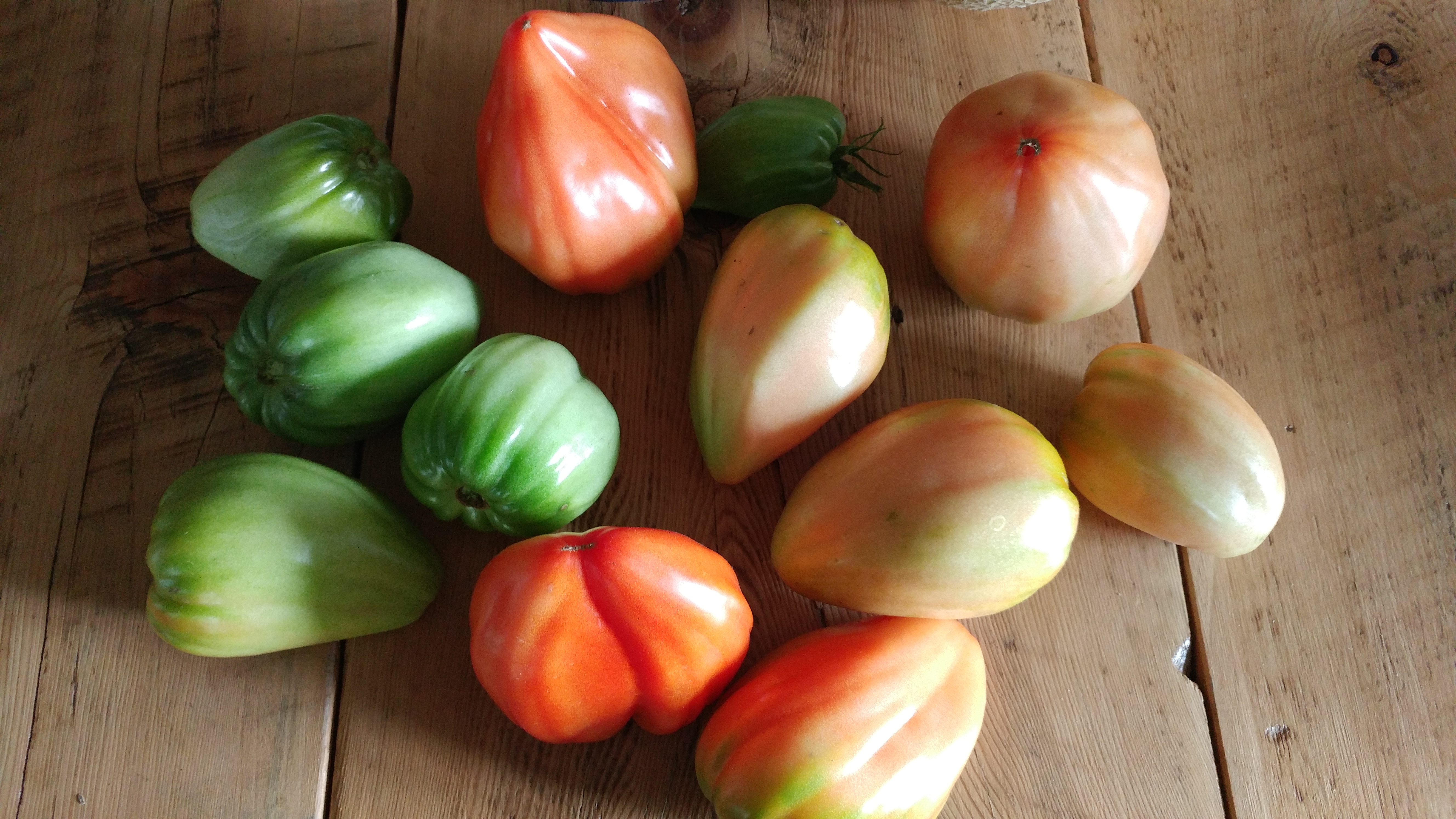
So anyway, back to the tomatoes. Anyone who knows us (or follows me) has heard of François’ famous tomatoes. They are an old heirloom variety whose name eludes us, from seeds passed down generations in Pasquale’s, (one of his Italian mushroom pickers) family. His great grandfather brought them over here like a century ago. François kept the seeds from the tastiest of his specimens and started them this winter, moving them into a greenhouse in the spring, and he lovingly tends to them every day with water and suckering, tying them up (they are 9ft tall!) and etc. He has planted some in the garden too and distributed seeds to other gardeners as well, in hopes to keep the variety alive.
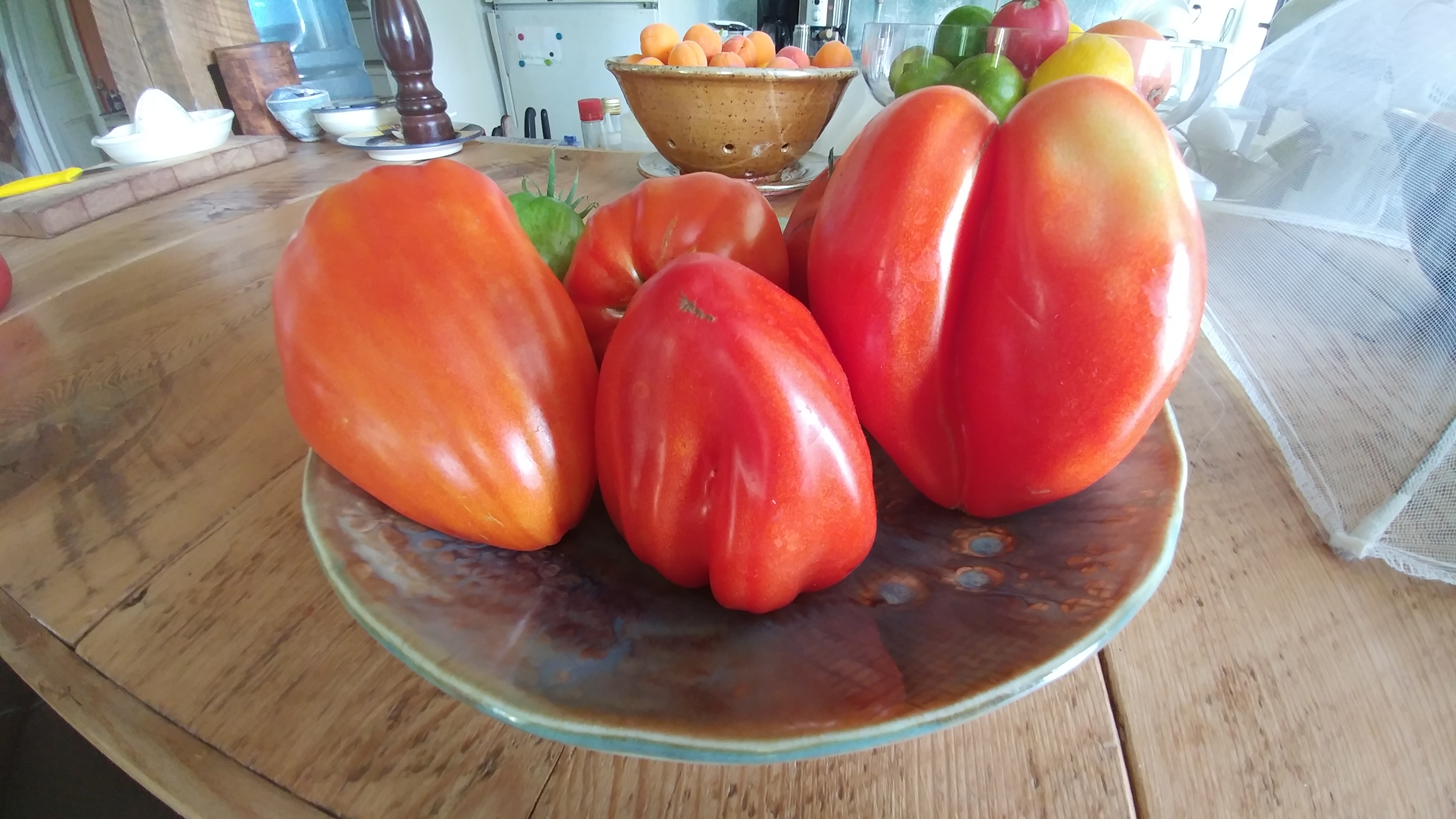
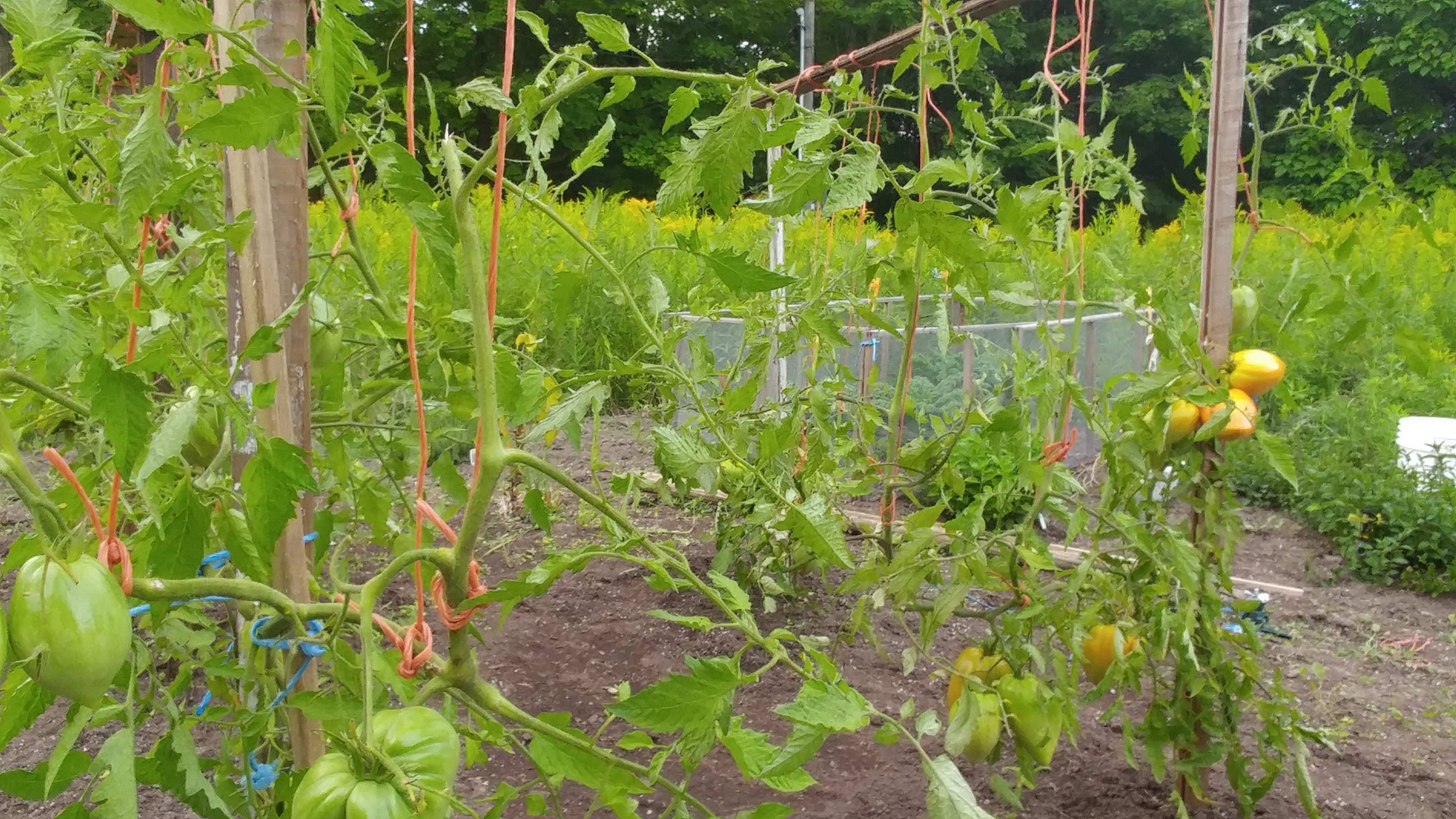
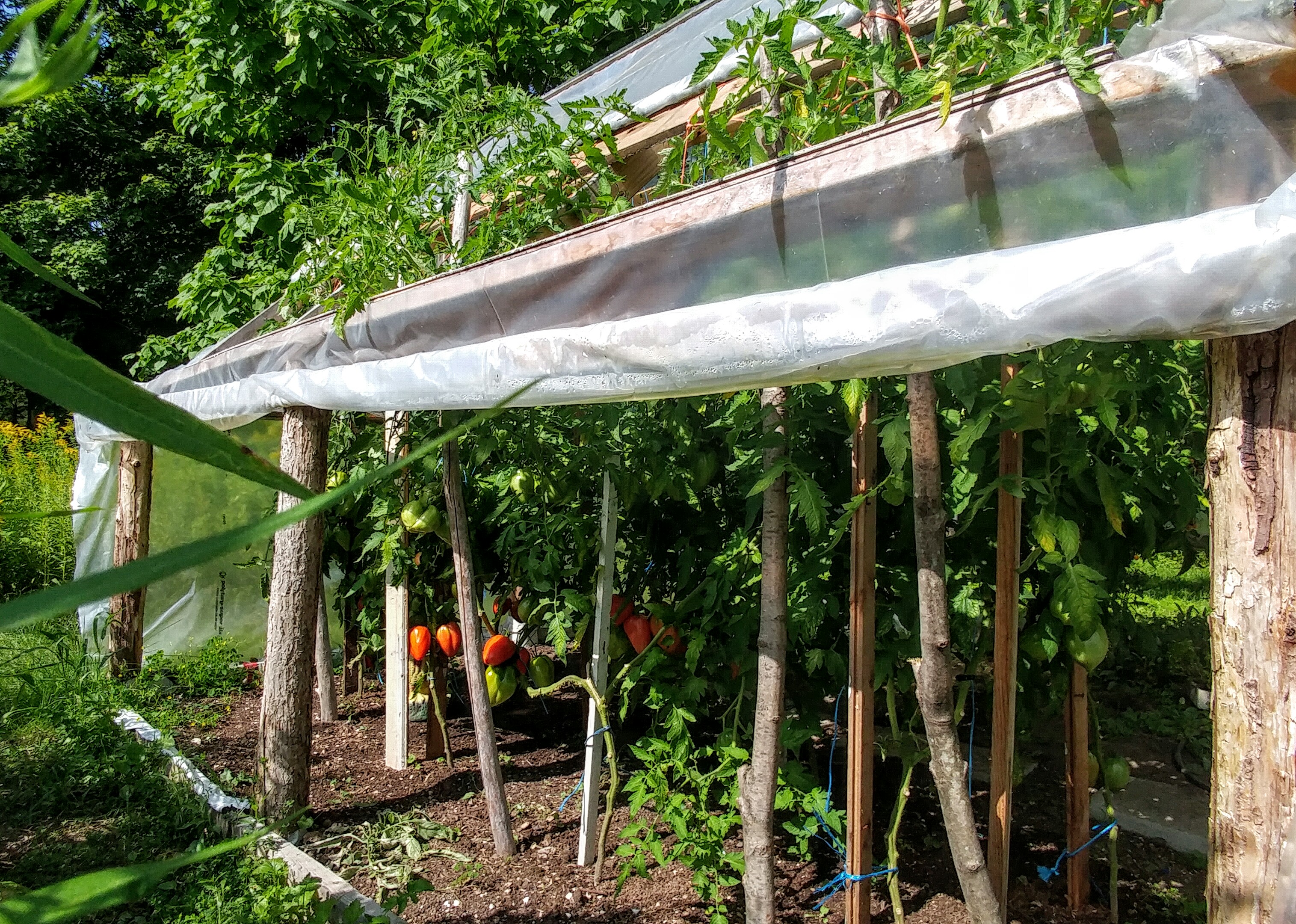 Greenhouse vs field, the taste test is on..
Greenhouse vs field, the taste test is on..
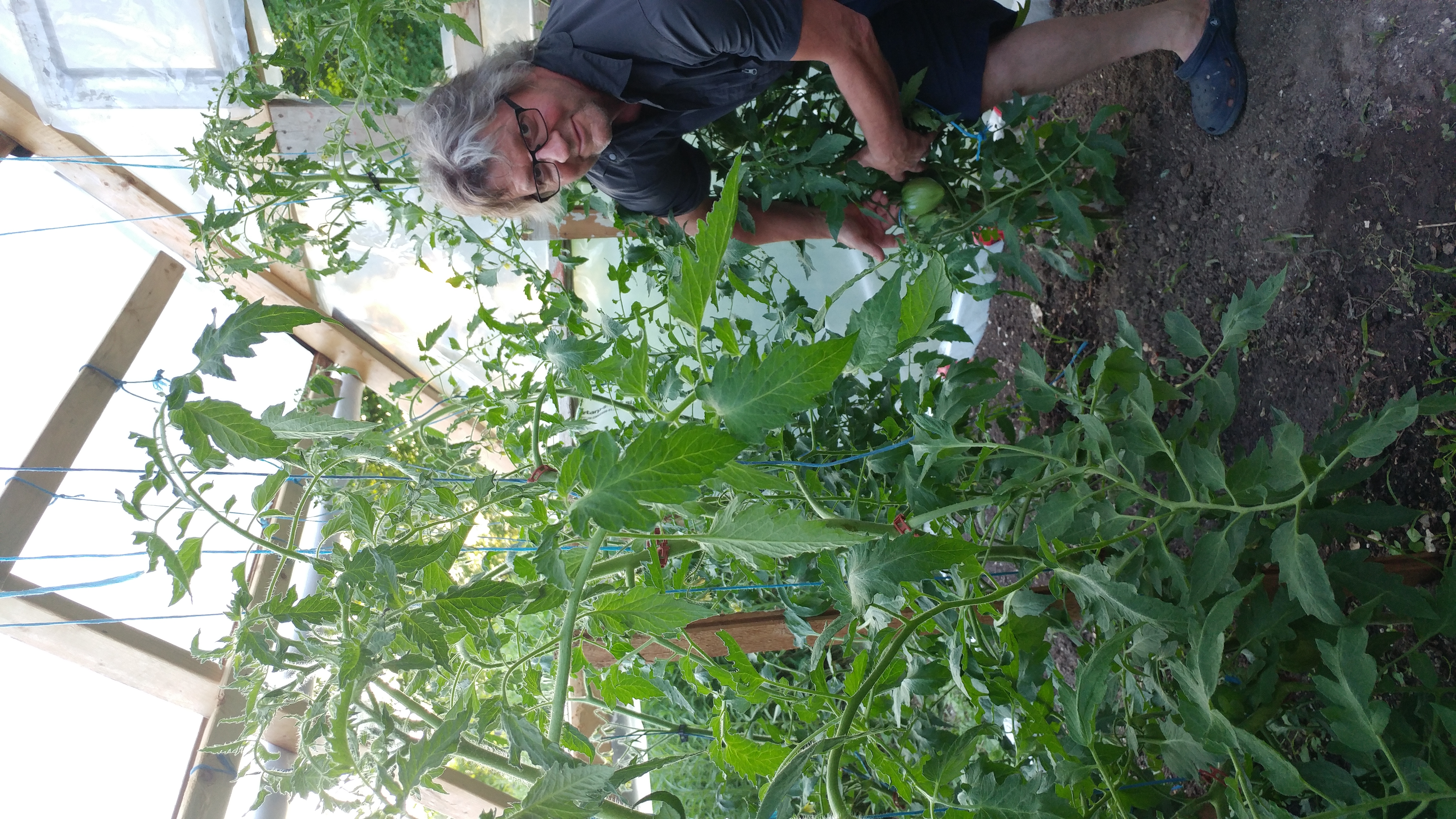 Proud green thumb
Proud green thumb
I can’t tell you how important his tomatoes are to him, and hence what an exciting time it is in our household now that they are finally becoming ready. He lays them out on the counter in order that they will be eaten and for different uses.. Woe and behold if I take too many to the restaurant or if I chop up the one that was meant for a sandwich, or yikes, slice it ‘the wrong’ way - Watch out for the St-Roch tomato police!
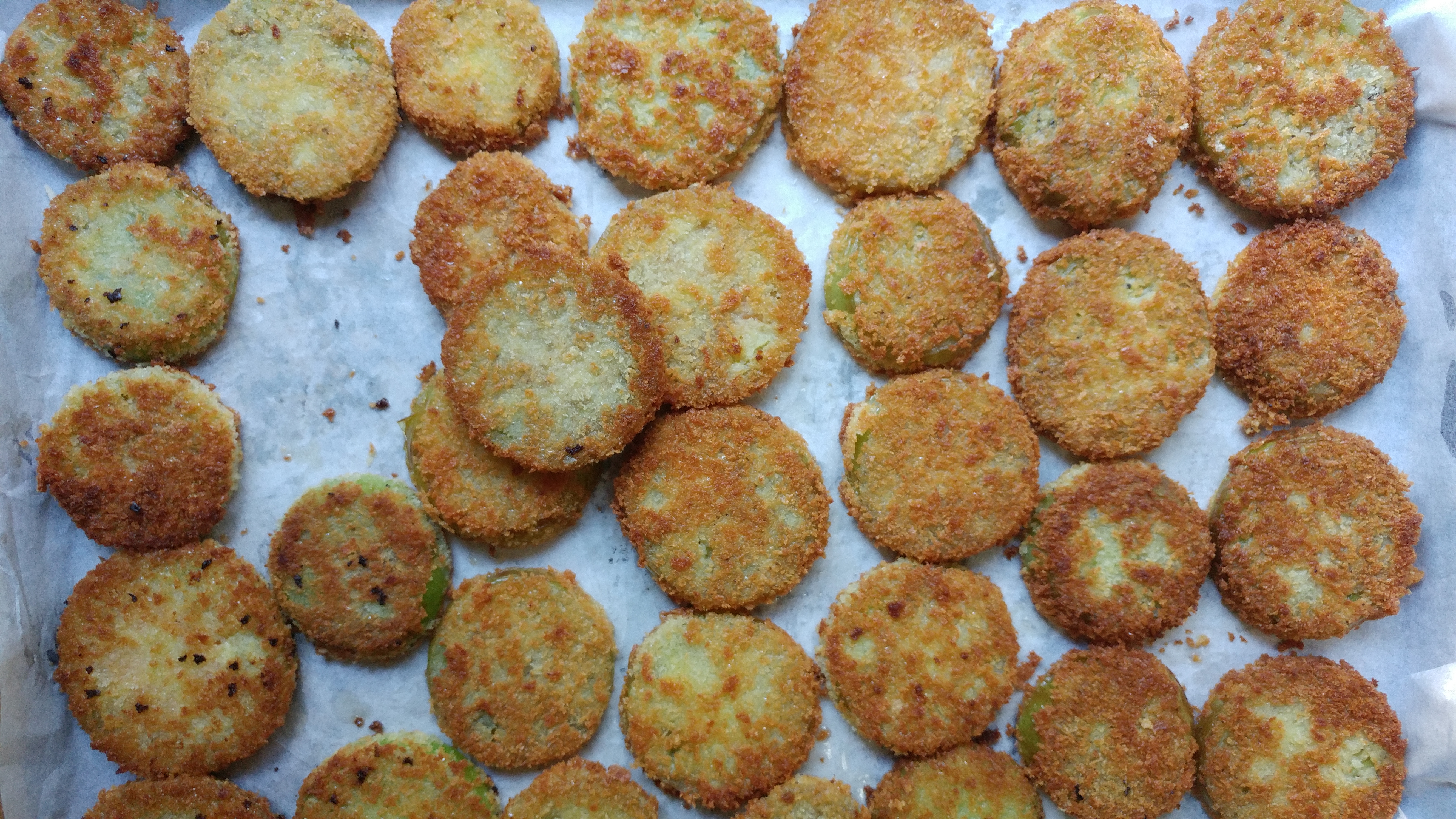
The first dish was of course Fried Green Tomatoes, which has become an annual ritual since we started making them (http://soupnancy.squarespace.com/blog-journalessays/2009/10/7/fried-green-tomatoes-finally.html), François just adores them. And besides, what else are you going to do with green tomatoes. Now that they are ripening, we are eating them in salads and salsa, with pasta and fish. They are meaty, not many seeds buy juicy, sweet and tomatoey, with a bit of tart. I like some acidity but François expects them to be succulent sweet and is banking on the garden ones.
He apparently has tomato tarts and pizza on the agenda, as he has ordered his dough (from me)..
At the restaurant – 1st entree of the moment: Fried green tomato with ripe and smoked tomato, corn, cucumber salsa, sea spinach and sea asparagus, crinkleroot lovage yogurt dressing, smoked eel, bee balm 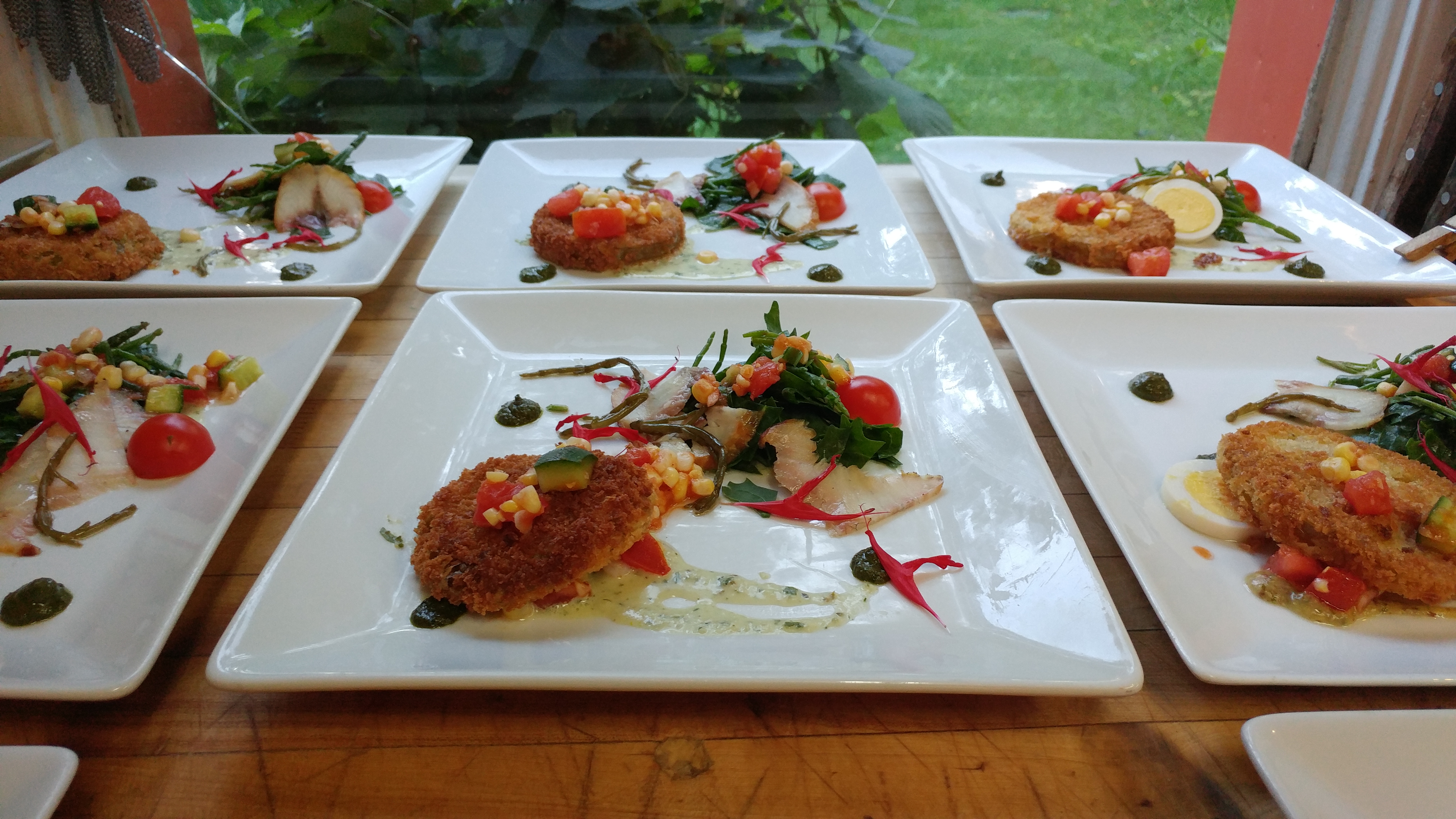
As the harvest really explodes later this summer/fall, I will be canning, smoking, making ratatouille and ketchup, etc..
But it’s not all about tomatoes or even the wild edibles, with the corn and beans, peas, favas, zuchinni and peppers, garlic, kohlrabi.. Lettuces, herbs, Plums, melons and peaches.. Not to mention the wild blueberries! And it will only get better in the month ahead, alongside the mushrooms. September is the best month of the year for food!
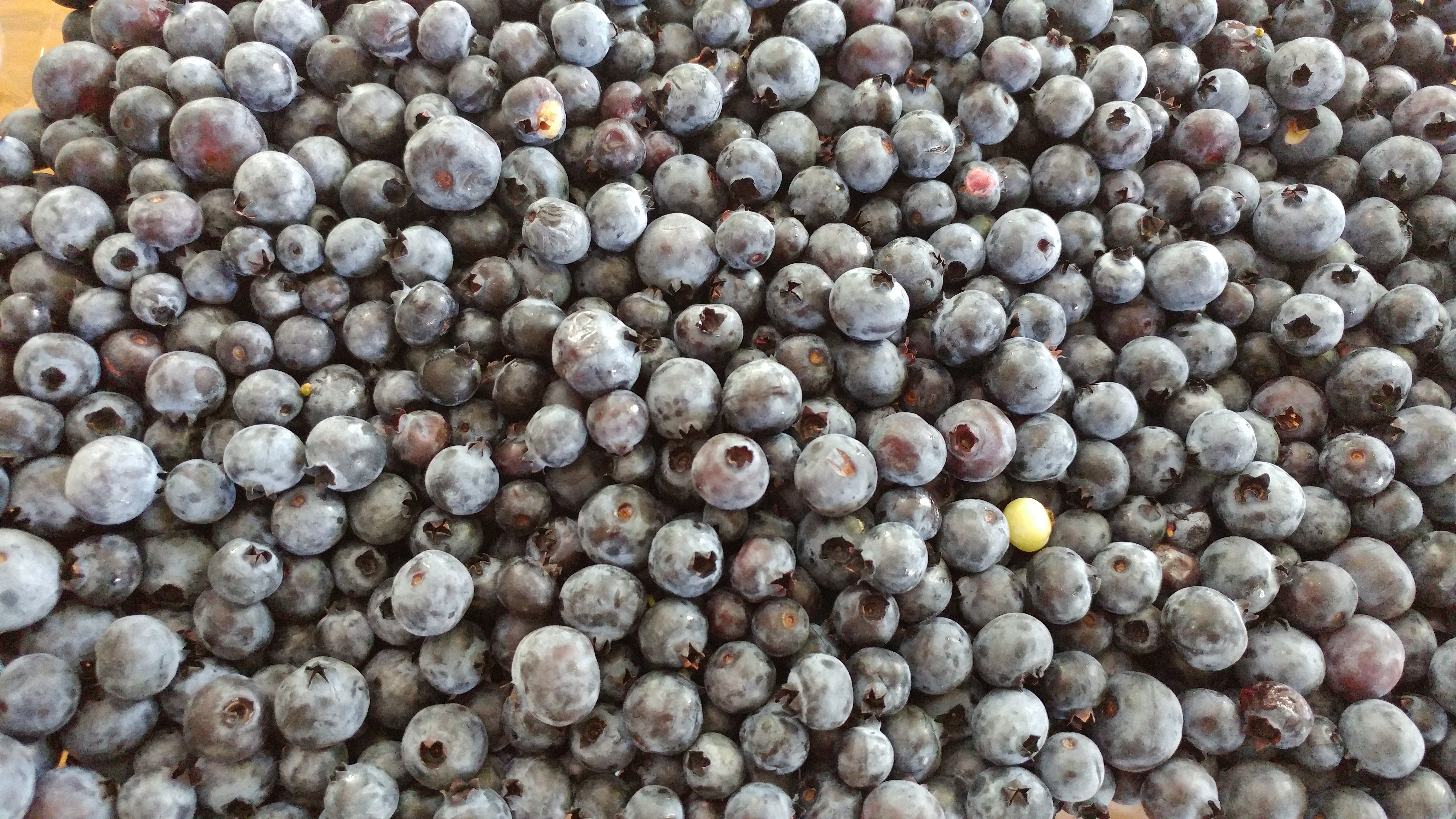
Some other summer hits:
A vegetable stew thickened with bread: ribolita - panzanella meets ratatouille, just a different delicious way to use the garden bounty or what’s hanging out in your fridge. Stew onions with celery/leek, peppers, add zucchini and whatever other veg you like (corn, beans..) Herbs and spices, A bit of white wine and stock or just tomatoes with their juice. At the end, throw in some croutons or dry bread, season and serve on salad with a good oil, aged vinegar and cheese shavings. Good as is or as an accompaniment to sausage, chicken or steak. At the restaurant, I was serving it with confit rabbit. 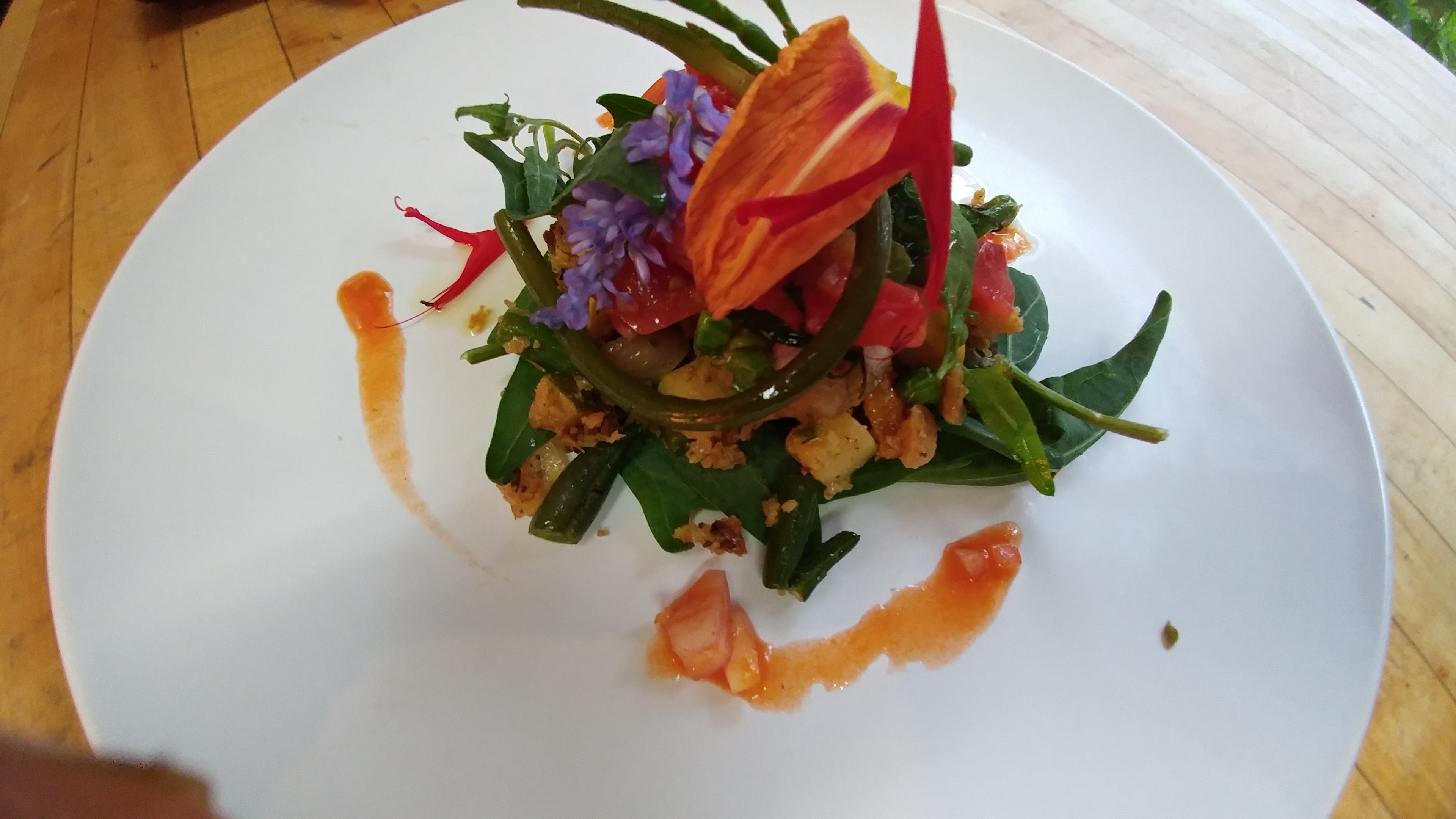
Fleur d’ail (Scapes) as a vegetable and as a condiment
In July when it’s scape time, we put them up for the year, alongside the wild stuff, a raw, green garlicky pesto. But it’s a beautiful time and a 2-3 week window (one for picking one, 2-3 for storing), when you can eat the scape as a vegetable, like an asparagus or green bean. It takes a 5 min. Boil. It is tender when it loses its bright green, sorry. Mildly garlicky, delish. Here the raw pesto is tempered into the hot potato mash, and the cooked scapes are a garnish. Alongside chanterelles which are in season at the same time. Just missing the corn, which would be perfect now. 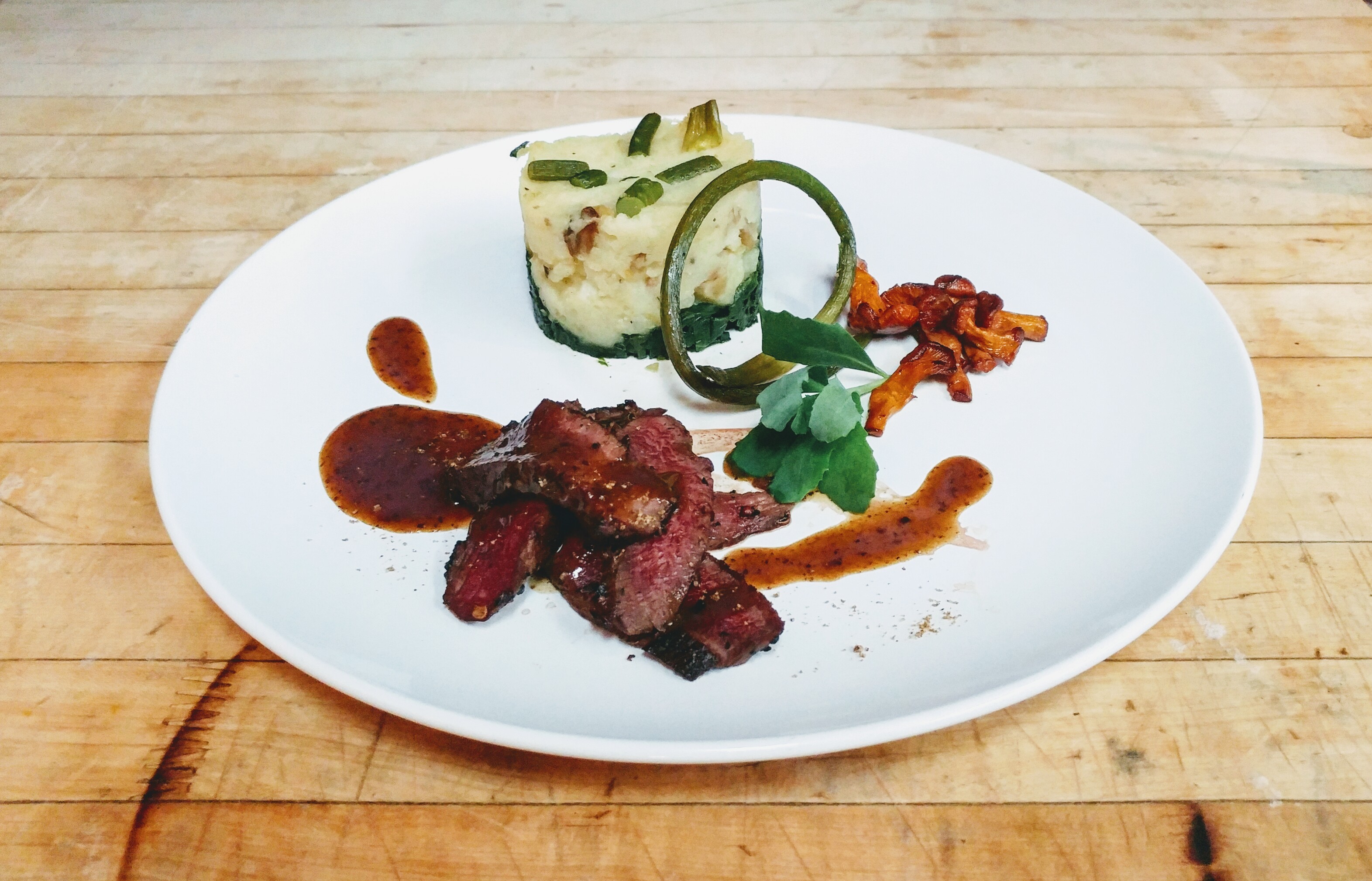
Vichyssoise (Stinging nettle)
Like a Parmentier or any puree/ green soup thickened with potato (so less cream). With stinging nettle and sea parsley, this soup is delicious, but it could be/is with many greens. I make a seasonal green soup with what is abundant, always good. Not only delicious, but nutritious. Served cold on a hot day or hot the rest of the time. Just a basic soup with onion, leek, celery, a touch of wine or vinegar, stock, herbs and spices, potato. Add wild greens. Finish with cream, milk. Tweak with salt, pepper, spice, acid, maple syrup.
Add a little garnish like this: cucumber, radish, lovage, sumac to lighten it up, or it could always be another to make it more hearty like bacon or smoked duck.
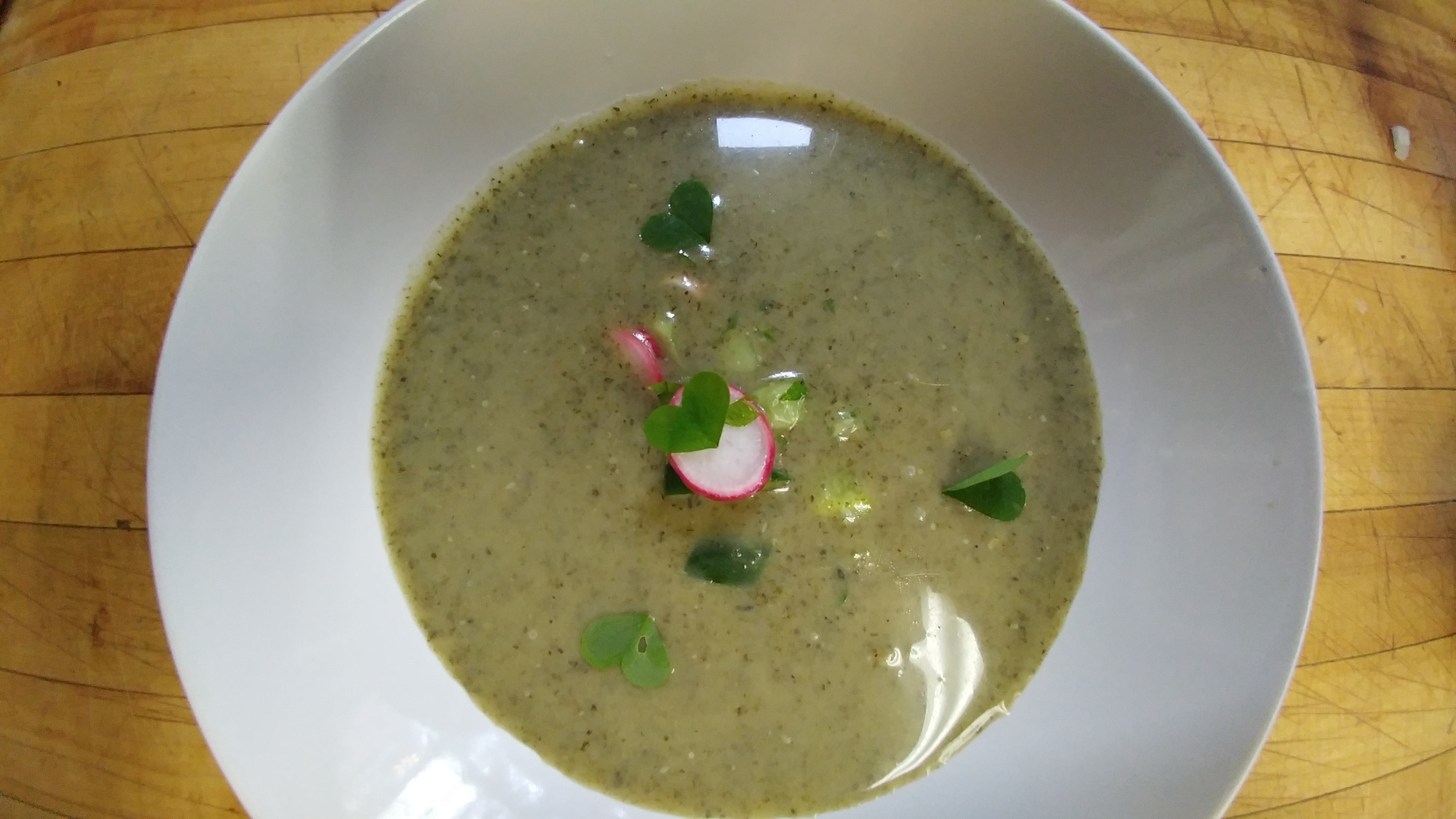
Mushrooms or not, it’s time to be hitting the market (and/or garden) and cooking up a storm!
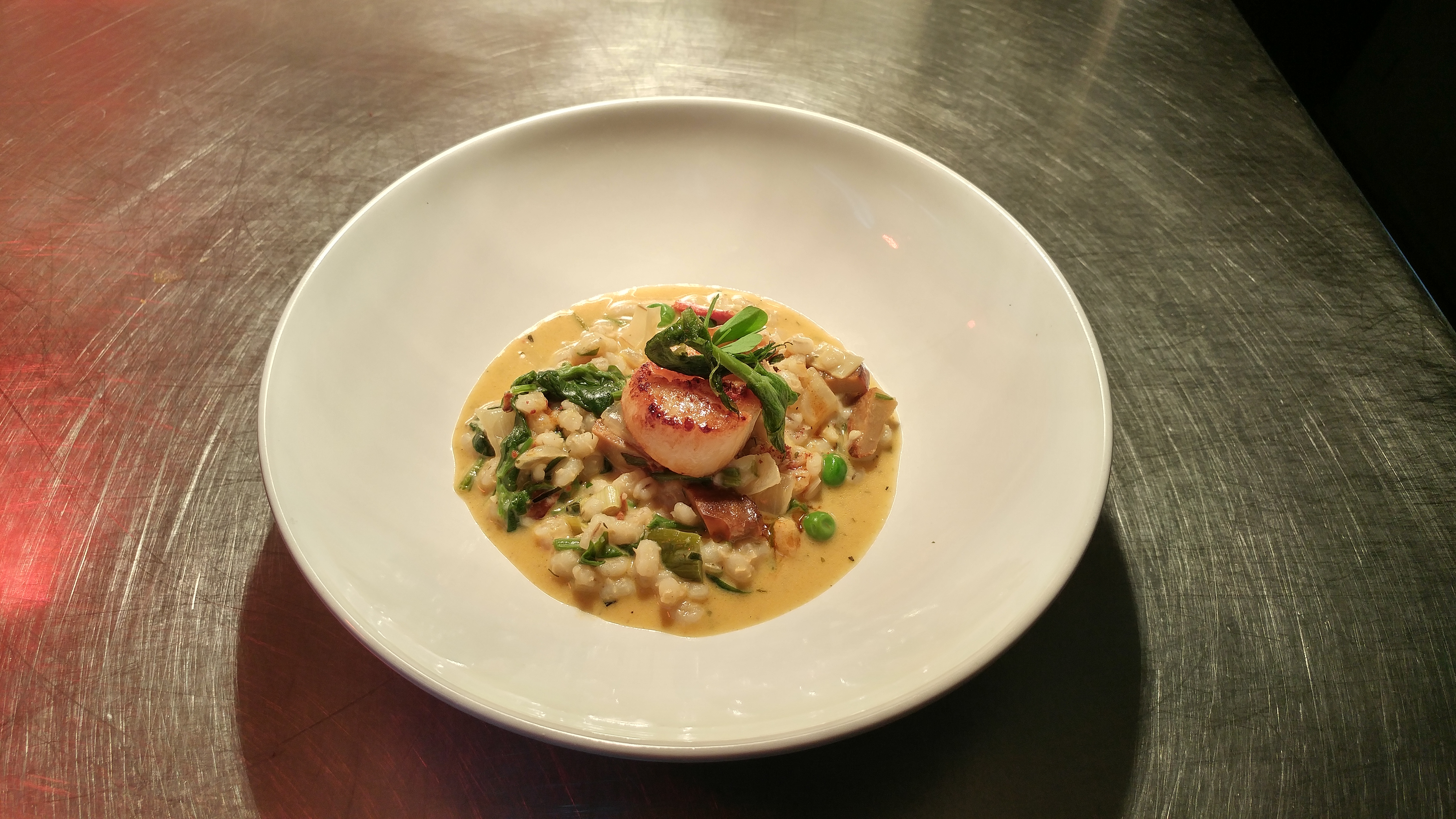 Lobster mushroom and lobster bisque risotto with beach peas, sea spinach and sea scallop
Lobster mushroom and lobster bisque risotto with beach peas, sea spinach and sea scallop 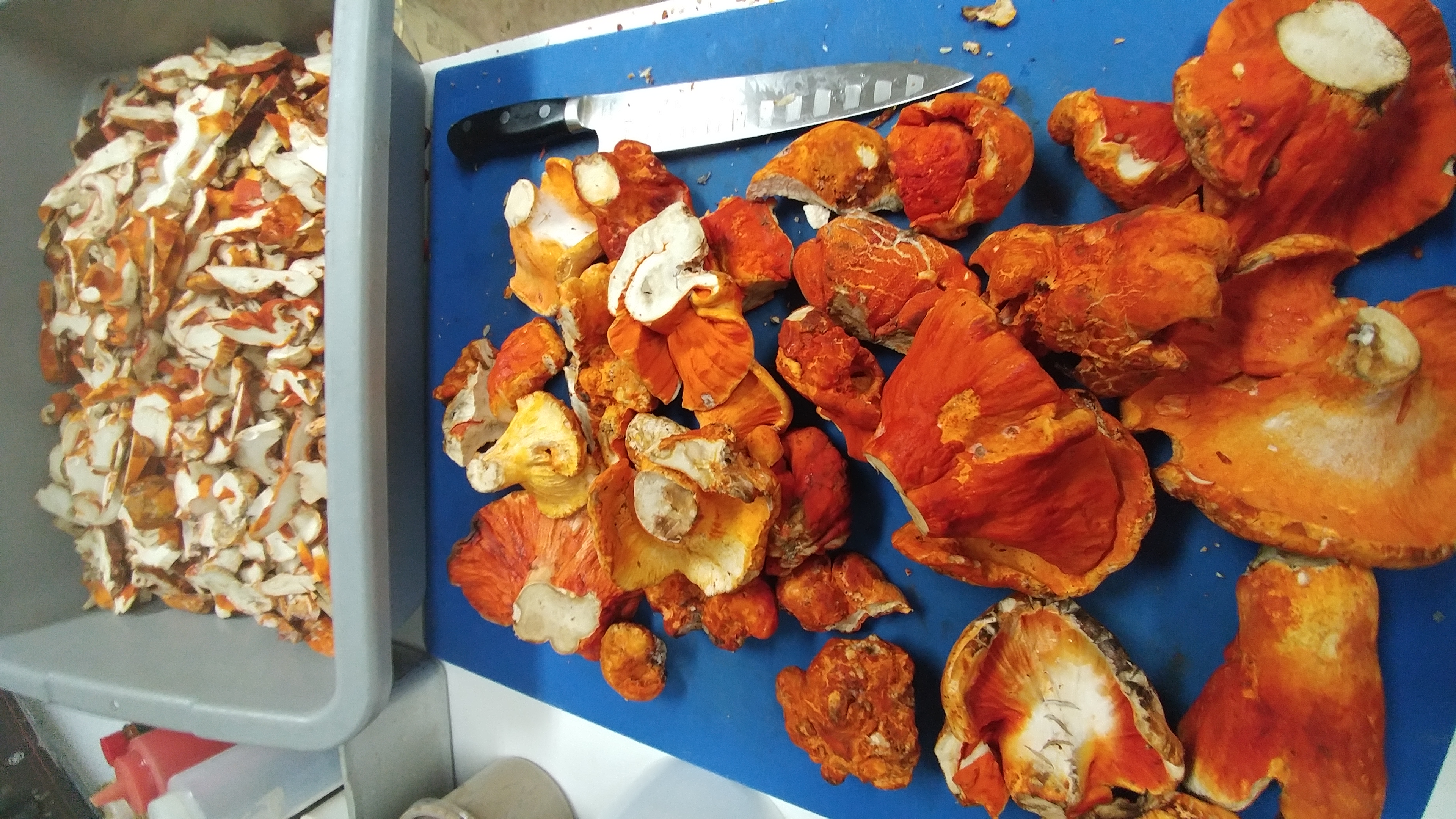 First significant harvest of Lobsters to put up
First significant harvest of Lobsters to put up
Foraging tips and recipes
With the current trendiness of local, seasonal food and notably wild produce, naturally many foodies and chefs are eager to have a go at foraging themselves. After all, it is a part of our heritage living off the land, a rural practical tradition that was slowly largely lost (luckily except for in my partner François’ family).
Wild edibles being our passion and business, (Les Jardins Sauvages a pioneer, thirty years in now), naturally we are delighted that people are curious and open to eating our terroir treasures; however, there is a downside to this trend.. Many among this new set however excited in theory are city dwellers and completely disconnected from nature; they are not afraid enough, or careless , wanting to go too fast without sufficient knowledge, or respect for nature and awareness of sustainability issues.
It is important to have some background information before attempting to forage on your own.
Equally, if you purchase wild food, you want to know that the seller is first of all certified with an official business, knowledgeable and respectful of nature, picking sustainably, mostly on private property if not owned then with permission. Especially restaurant Chefs who are dealing in larger quantities should take responsibility when they put foraged foods on their menu, ensuring that it is from a reliable sustainable source (paid for with bill). The increasing number of hacks and black market is dangerous on all levels not only in terms of sketchy product commonplace, but in terms of sustainability of the resource with no traceability (picked how, where, by who). Not to mention that without the overhead of running a business, these occasional pickers crash the market making it difficult for an experienced business like ours doing it right, working with the government and schools, dealing with inspectors and paying taxes etc. (and who paved the way to boot).. Awaiting regulation, the best we can do is keep doing our thing while educating..
I recently hosted a crew of explorers who were here for a forest cooking competition (Woods Greatest Canadian Explorer) in a survival type series of challenges (airing July 28th) https://www.youtube.com/watch?v=aIvl5CWwZdw . We gave them a crash course in foraging with many of the wild edibles on our property before they had their cook off using wild foods and regular camping gear and dry goods. When customers come to the restaurant for a workshop dinner too, these are the main points we share with them about foraging before they go out identifying and tasting with François.
Bonus below are also a couple of easy recipes that you can dress up or down, meant to be doable while camping.
Foraging Tips
Chef Nancy Hinton, Les Jardins Sauvages
Know what you’re doing!
Ensure proper identification. Don’t rely on only one book (especially with wild mushrooms).
Ensure proper picking, both for taste and Mother Nature. There is a specific way for each wild edible (how, when and where).
Some greens are hardy, growing like weeds in the right environment (like lambs quarters, garlic mustard..) while others have a slow reproduction cycle so can easily be endangered if over-harvested (like ramps/wild garlic, wild ginger, crinkleroot). Don’t touch unless you know the life cycle of the plant and that it is in a healthy population.
In general, don’t rip out roots. Prune tips or leaves from mature plants, leaving buds; leave young baby sprouts alone.
Leave more than you take.
Besides for sustainability, there is also a proper way to forage for deliciousness and digestibility. Some plants are best picked in the morning (say dandelion), others at noon (say some flowers and goats beard).. Some plants are tasty when growing in a moist humid shady wooded area, while bitter, even inedible in a dry sunny season or spot, as with live-forever, wild rocket and mustard, sea chickweed..
Keep in mind that many wild edibles need to be cooked, for example: fiddleheads, milkweed, most wild mushrooms. It is a good idea to wash your harvest. When cooking, follow your palette: If it is pungent, use sparingly like an herb; if it is mild, then use as a salad green or vegetable.
Don’t be in a rush. Be cautious, not stupid.
Books and google searches might be a fine help, but there is no shortcut for experience.. Time in the Woods is Key! The best way to learn about foraging is to get to know your property or a patch of land/woods nearby that you can visit often, observing patterns, trees and what plants/mushrooms grow where every year, including the impact of your harvest (if you have permission to pick.) Start with a few plants and mushrooms, get to know them well and slowly widen your scope every year.
Some wild greens/vegetables to explore without fear: Live-forever, trout lily, violet leaf, day lily, fiddleheads, lamb’s quarters, amaranth, garlic mustard, wood sorrel, sheppard’s purse, wild mustard leaf, wild celery/lovage.. Always keeping an eye out for familiar wild berries, wild mint and chives..
Some wild mushrooms to start with:
Boletes (A family of hundreds including Porcini with the sponge under the cap) – While not all are of interest, they are not dangerous.
Lobster Mushroom – characteristic red colour and shape
Chanterelles – there is only one ‘look alike’ and easy enough to differentiate
Oyster/Shelf mushrooms on maple trees. Most are good when young, avoid really old rotten trees.
Be afraid of very pretty picture perfect mushrooms – often the deadliest!
Fish baked with crinkleroot, tomato and wild herbs
Chef Nancy Hinton, Les Jardins Sauvages
4 portions
Ingredients:
500g fresh fish fllets (or 1x 2lb whole fish, gutted)
45ml Butter and/or olive oil
1 c (250ml) shallots or onion, sliced thin
60ml (1/4c) sliced wild garlic (or 30ml minced garlic)
15ml (heaping Tbsp) steak spice
125ml (1/2c) white wine
30ml (1 Tbsp) crinkleroot (or horseradish)
375ml (1 1/2c) diced tomato (1 can)
250ml (1 c) heavy cream
1.5L (6 c) wild greens such as lambs quarters, sheppard’s purse/wild rocket sprouts, mustard leaf, amaranth..) or spinach/greens of choice
60ml (1/4 c) wild herbs such as wood sorrel, garlic mustard leaf, lovage, ramp leaf, chives, angelica, yarrow.. (or dill, tarragon, basil/ herbs of choice)
To taste salt, pepper
To taste hot sauce or chili
Method:
The fish can be cooked whole and served off the bone too. It all depends on your camping set up and mood.
Sprinkle the fish with steak spice.
Heat large pan or pot on burner or fire, sweat onions in butter/oil a few minutes, add garlic and crinkleroot, then white wine, tomatoes and cream. Place fish in sauce and top with wild greens and herbs, season to taste. Cover and bake or cook gently for 15-20min or until just starting to pull apart. A whole fish will take twice as long.
For the simplest method: All the ingredients can be put in a covered pot on the fire or in an aluminum foil packet (en papillote)..
Wild Mushroom Rice bowl
Chef Nancy Hinton, Les Jardins Sauvages
4 portions
Ingredients
225g wild mushrooms (such as chanterelles, hedgehogs, lobster mushroom, young king or yellow boletes, black trumpets..), cleaned and sliced
45ml grapeseed or olive oil
15ml (1 Tbsp) butter
1/2c (125ml) chopped shallots or onion
30ml (2 Tbsp) wild garlic (or half as much garlic), sliced thin
10ml (2 tsp) wild ginger, minced
250ml (1c) long grain rice like basmati
125ml (1/2c) white wine
30ml (1 Tbsp) dried mushroom powder
375ml (1 3/4c) water or broth
To taste Spices (ex. clove, bay leaf, pinch thyme or curry powder..)
To taste salt and pepper
1L (4c) Mix of wild greens and herbs such as lambs quarters, dandelion, wild rocket, ramp leaves, day lily shoots, daisy, sorrel, mint.. (or say spinach, watercress and basil, coriander, mint..)
30ml (2 Tbsp) Olive oil
Optional splash sesame oil
100ml pickled mushrooms, fiddleheads, kimchi or pickle of choice
To taste Chilli/hot sauce
Method:
Sauté mushrooms in a hot pan with oil. Once they start to colour, add the butter and onions and turn down the heat to medium, cook a few minutes and add the rice, garlic and ginger, stir to coat the rice. Add the mushroom powder and wine, reduce slightly. Add the water/broth, season with salt, pepper and spices of choice. Cover and cook over low heat for 15-20 minutes, until rice has absorbed liquid and looks almost done. Remove from heat and let sit 5-10 minutes.
Meanwhile, toss greens and herbs with a good oil, salt and pepper.
Serve rice topped with salad and pickle.
Add a fried egg, tofu, cooked sausage, leftover chicken/steak or protein of choice for a more substantial meal.
Mushroom aroma Magic
The magical world of mushroom aromas - A lot of je ne sais quoi
Tis the season. I am processing hundreds of pounds of mushrooms every week – cleaning, slicing, dehydrating, blanching or cooking, pickling etc. A ton down now, with another ton to go, I am living in a mushroom cloud. Boletes, Chanterelles, Hen of the Woods, Puffball, Hedgehog, Yellowfoots, Matsutake are all perfuming my kitchen, headspace, car, curtains and clothes..
Some of my Mushrooms in pics..
After all these years at Les Jardins Sauvages, I know the 30+ varieties that we harvest intimately, and I am enchanted by their heady scents year after year.. I have a good nose but always have a hard time nailing the damn shrooms with words, reminding me of my first winetasting class. They are not only mysterious and elusive in the woods, but on the palette – each one characteristic and complex, so hard to pin down.
Unmistakable, unique, nothing smells like Matsutake mushrooms for instance. Fresh, in the oven or dehydrator, they are seriously intoxicating on different levels. Cinnamon and Flowers definitely; one year I noted violets/lilacs, this year I say rose ?? plus a lot of je ne sais quoi..
My car still harbours the lingering odor of freshly picked baskets of porcini from a week ago - another mushroom that leaves its mark. Fragrantly earthy, nutty and sweet smelling, even better in the pan or yet the dehydrator, where an entirely different set of aromas develop: vanilla, soy, coffee and spice. Hen of the woods roast up like chicken and corn, wild oysters like almonds and chicken. Others smell like walnuts or citrus (Delicious Lactarius!), it’s crazy. Puffball can be pungent and black trumpets musky but like with cheese or truffle, there is such a thing as 'good stink' that translates into great taste.
When cooking, the aroma notes like 'chicken' are often associated with the Maillard reaction (caramelising sugars & protein) mixed in with what I call the forest (piney/woodsy/nutty etc). However, with many shrooms, especially in the bolete family, once dried, you get a whole other family of increasingly complex, often exotic aromas that you don’t get fresh or cooked – fruity flavours, vanilla, chocolate, caramel, butter, coconut on top of the nuts and earthy notes. This last group I call ‘sweet’ because I associate them with dessert. The red mouthed bolete, larch bolete, slippery jack and Maple scented Lactarious are incredible naturals in the sweet kitchen.
There is something hauntingly addictive about wild mushrooms. Many nature lovers get hooked in the hunt, whereas with cooks and gourmands, it is at the stove and table. Beyond their deliciousness, nutritional content and newfound medicinal properties, they win you over with their mystical aromas. Then with their flavours of course and omnipresent umami kicking in with protein and minerals, texture and mouthfeel, plus whatever bonus the accompanying recipe delivers. Mushrooms are fine dance partners, pairing well with a delicate fish or slab of red meat; they can jazz up a sidedish or take the leading role in a pasta, tagine or risotto, ice cream or cookie. There is a mushroom for everything.
I obviously love my shrooms and I have picked them apart, figuring out which ones are best cooked or dried, braised or roasted, pickled or candied, steeped or pulverized. I spend a lot of time cooking them and teaching people how to prepare them. Everyone wants to know how to pick and cook, but it’s the aromas that fascinate me most. I know them almost better than my family, but I have just about given up trying to describe their nuances. A few years ago, I had employees participating in my little shroom sniffing exercise like a wine tasting, but it got me nowhere beyond laughs. Ok it smells like my grandma’s apple pie (so you mean apple and cinnamon?, I guess). I look at my notes from the early years and I see ‘maple’ for chanterelles or ‘pine nut’ for matsutake.. And this is true, but now I’m no longer objective, I know them too well, it’s that they just smell like themselves, like a ‘Chanterelle’ or a ‘Matsutake’, as a pear smells like a pear and an orange an orange.
And I guess, that’s enough for me. I’m at an age that I have no problem accepting some magic and ‘je ne sais quoi’ in seeking out and understanding the truth about things. There was a time too when I was bent on figuring out what molecule (a protein I thought) in certain boletes that creates a solid emulsion, to hear from a scientist that it was probably a complex saccharide of some kind; anyhow now I've moved on, comfortable with what I understand, able to exploit or avoid its emulsifying properties without delving into the chemistry.
Plainly viscerally, I have simply discovered a marvelous world of aromas with mushrooms that few people are aware of. I might be done with over analysing, but I do encourage you to sniff your mushrooms.. And I can’t help but think François Chartier would have fun attacking this one day. Let’s just say that a mushroom is not a mushroom and any one way more complex than a stick of celery or stalk of rosemary.
My Stupid Mushroom aroma notes
Agarics Champêtre very mushroomy, toast, fruity chocolate (cherry blossom), truffle
Armillaire Ventru mild but with a bite, toothsome texture, nutty, ostie/church wafer; chemical off notes with high heat; dried: fruitcake, spice, citrus
Bolet baie buttery, fruity, excellent, rare (boohoo)
Bolet insigne moka, molasses, hickory
Bolet jaune toffee, vanilla, coconut, butter
Bolet orangé roasted nuts, major floral component
Bolet à Pied Glabrescent fragrant, subtley floral, honey, caramel, green nutty as in stone fruit pit, caramilk
Bolet à Pied rouge very fruity, vanilla, chocolate, playdo
Cepes aromatic and meaty (roast beef), soy, vanilla, coffee, cinnamon, nutmeg
Cèpe des Mélèize very sweet, moka, chocolate, vanilla, butterscotch, strawberry ice cream
Chanterelles maple syrup, almonds
Chanterelles Clavaires earthy, meaty, maple syrup, almonds and coconut
Chanterelles en Tubes hot milk, cappucino, caramel
Coprins meaty, woodsy, walnuts, long cooking best
Hygophores apricots, chicoutai
Lactaire Délicieux brittle, delicate, floral, walnuts, citrus
Lactaire couleur de sui citrus, flowers
Lepiote lisse mushroomy, much umami, soy, nuts
Lobster mushroom firm texture, not much flavour, but yes lobster, earth, fresh esp dried: fresh, coconut
Matsutake particularly aromatic, unique: floral, fruity and earthy all at once, chewy texture, citrus, pine nut
Mousserons supremely delicate, coffee, honey, citrus, bitter almond, kirch
Morilles deep and earthy, musty, intense but subtle, truffle, coffee, spice, chocolate, oreo cookie
Pied bleu Strong, meaty, nutty, sapin, peppery, vegetal
Pied de mouton Mushroomy but fresh, acid, buttery even cheesy, cook low heat, dried: butterscotch, almond paste
Pleurotes(automne) delicate, almonds, bbq chicken
Polypore Souffré Watermelon, lilacs, corn, lemon
Polypore Poule des bois Delicate, chewy, melon, corn, roasted chicken, almonds
Trompette de la Mort Sweet and deeply earthy but fresh, complex, truffle, licorice, beurre noisette
Bye bye salicorne, Hello shrooms
After a good month of feeling spoiled with a myriad of marine greens garnishing my plates, the season is sadly coming to an end. I have enough spicy sea rocket to make a salse verde for my current menu, a little Canadian sandspurry (that tastes like beet), the sea asparagus is done - gone woody. My favourite, the sea spinach is the only one I put up for the year, blanching and sous-viding it for the freezer so that I can cook with it, but best get my salad fix now..
François was the first to put these greens on chefs menus twenty years ago, but now a new generation of chefs are waking up to them too.. They grow along the lower north shore, and from the Lower St-Lawrence to Gaspesie, and François has found the perfect spots managed now by Claudie (Les Jardins de la Mer). Taught by Francois and a part of our team, Claudie is ‘the queen’ who has made these greens her life in the Lower St-Lawrence. Picked by her or François, you know they are properly sourced, tasty and clean. This article featuring François’s August pickings (in French): http://www.lapresse.ca/vivre/gourmand/cuisine/201308/28/01-4683958-plantes-de-mer-du-littoral-a-la-table.php
Now, it’s more than time to focus on the shrooms, and yes, they are sprouting.. The chanterelles are just beautiful, and the lobster mushroom too (not my favourite, but this year, I feel a soft spot), a good year for gypsy mushroom.. Now, the hen of the woods is taking over as star (a definite favourite!), autumn cepes are happening and there is a trickle of hedgehogs and yellow-foots, which will be the next boom. We have over a thousand pounds down (as in processed and put up), another couple to go, weehoo!
Photos.. https://plus.google.com/photos/103408259485441464988/albums/5919231057095014049?banner=pwa
And as the mushroom season progresses, I will be posting shots from our 2013 harvest here: https://plus.google.com/photos/103408259485441464988/albums/5919231057095014049?authkey=CMms0sb1m9WLZA
